1979: Act 4: the Information technology revolution ( = death of the FF)

 FF201
202
203
annual 12
204
205
206
207
208
209
210
211
212
213
214
215
annual 14
216
217
218
FF201
202
203
annual 12
204
205
206
207
208
209
210
211
212
213
214
215
annual 14
216
217
218

Summary
1978-79 was when American universities began to use the Internet.
Notice how the FF is often ahead of the curve, as with the rise of
atheism (act 3 part 1), the
rise of east Asia (act 3 part 2), and the importance of 1978. Here we
have another example: the I.T. revolution. The longest
arc in the whole 28 year story is about the quest for Xanadu (Xandar):
immortality through computer networks. Issues 202 and 209 specifically
reference the power of networked computers.
The "Übermensch", redux
This living computers story is essentially a repeat of the "Übermensch"
parable from 100 issues earlier (which then held the record as longest
arc). It is all about the greatest of Great American themes: all people
are created equal. It is about the futility of trying to do the
impossible all on your own, and the need to listen to your family. For
details see the notes to FF 117. The period begins with Reed thinking he
has finally won: so he wants to disband
the team. They have nothing else to do! But he never fixed the
underlying problem: he never put Franklin first. After this
everything will unravel, and Franklin will pay the price.
201
Issue 201: the family is not safe after all
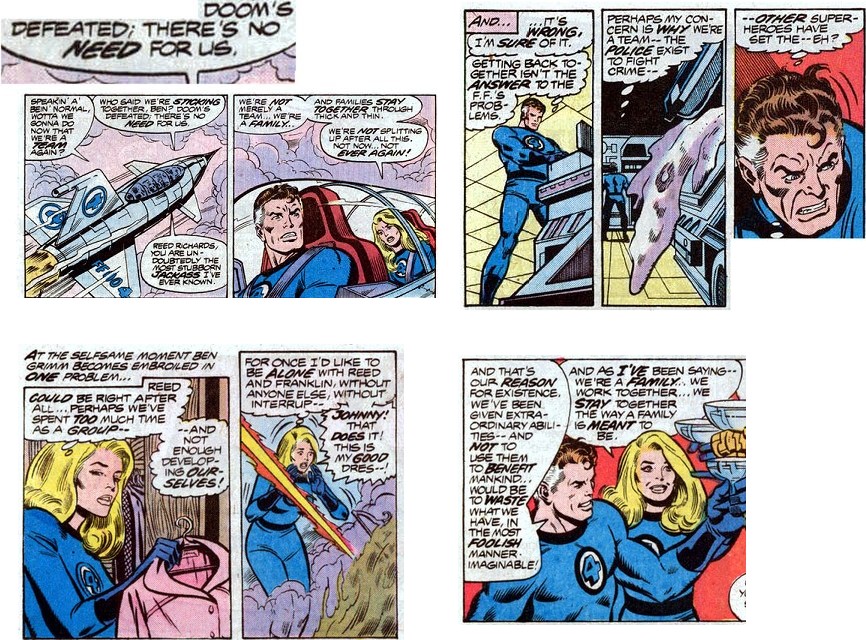
A highly symbolic issue
The Fantastic Four is about Reed's position as head of the
family. In 200 he seems to have proven this once and for all. But here,
the very next issue, just as they are celebrating, the family home
attacks them. This symbolizes what is to come: F200 did not protect the
family. it was a false dawn. The family, symbolized by the home, cannot
be as happy as long as it relies on force (e.g. technology) rather than
love (e.g. treating Sue and Ben and Johnny as equals; putting Franklin
first).
In this issue Reed's own inventions turn against him. This
symbolizes what will happen until the end of the act. He thought
that with the defeat of Doom everything would be easy, but instead
all his achievements begin to unravel. Everything that made Reed
feel good about himself will fail. Before the act is finished reed
will finally learn humility.
The job is done: the team can disband?
Reed's very first appearance (in issue 1) had him saying he prayed he
would never have to call the FF together again. He never wanted this
team, and now he thinks he has got his wish. But Sue reminds
him that they will always be a family. Note that she does not
particularly care for being a superhero (see FF195) but she just
wants them to be together.
Sue is the only balanced
character
Note that Sue shows the full range of healthy emotions: she is the
only one to do so. Contrast Sue with the others who can only
bottle up their feelings and suffer in frustration.
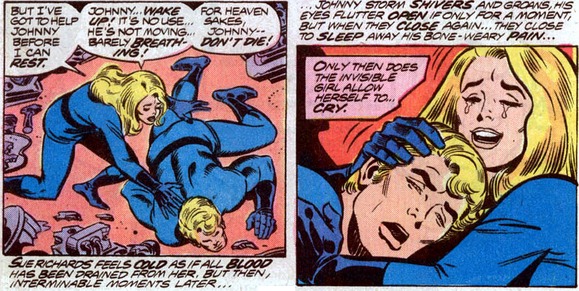
Even while showing her independence and skill, Sue acknowledges
that "Reed was right" - this is a reminder that Sue is balanced.
She does not have his fragile ego. She listens to Reed and
benefits from it, and does not feel threatened by doing so.
Contrast with Reed who can only listen to himself, except when he
has no choice (e.g. in FF200 about kissing).
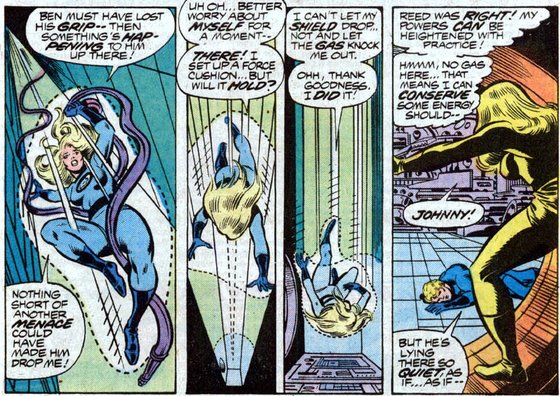
Note that at this stage Sue cannot use her forcefield to simulate
flying (except for short distances, as shown on the cover to
FF173). This is not because she lacks imagination, but because she
has not yet got the power boost from reversing the skrull aging
ray (FF214).
202
Issue 202: the Internet: a new beginning
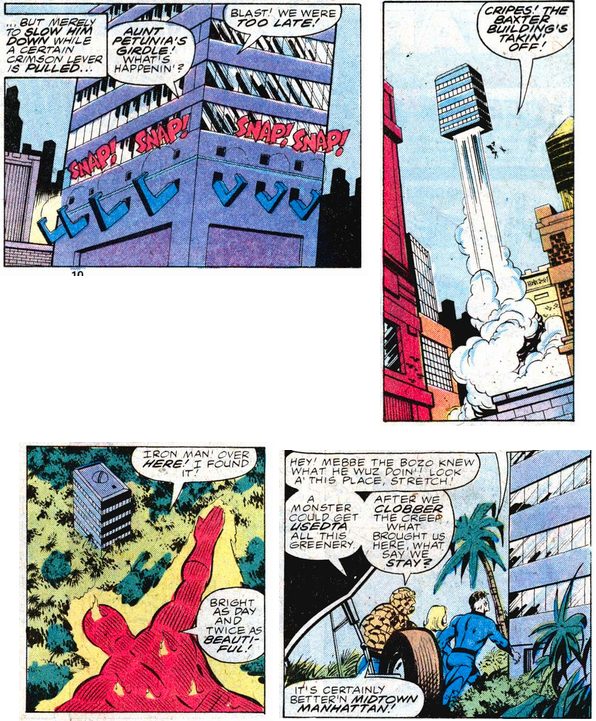
The Baxter Building leaves, symbolizing a break with the past. It
settles down in the middle of a forest: this foreshadows what Reed
should do next (see the next
generation). Reed needs to set up his lab in some beautiful
spot where Sue can be happy riding her horses, and where they can
both concentrate on Franklin. Note that Ben prefers this country
location to New York.
Maybe Quasimodo has calculated that this is good for the team? He
does not want to kill them at first - he removes the building so he
can get out of their way. True, he was designed to kill, but in this
issue he seems to be breaking free of his primary programming, and
instead wants to get away and achieve something greater. He only
attacks the FF because they follow him and he thinks they will stop
him reaching the stars.
The new start is also symbolized by the Internet:
The Great American Novel and the Internet
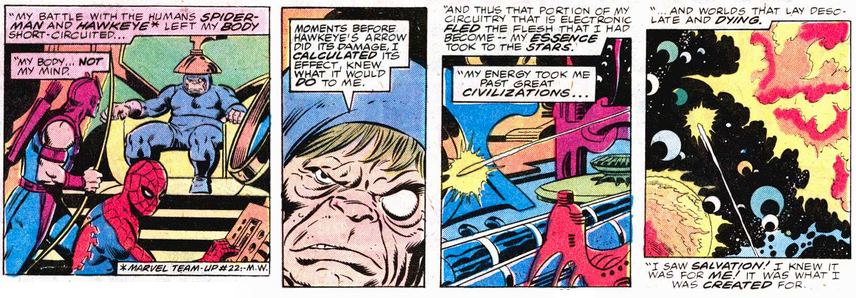
The Great American Novel shows the development of all the great themes
in American history. Here we have the Internet. This whole arc, from
Quasimodo's origin to Xandar [Xanadu], is about the
Internet. This was clearer in the non-FF story that led up to this,
Marvel Team Up
22. Quasimodo's mind exists in cyber space, and his power is based on
linking the world's computers.
"Still imprisoned in the tubes, the
heroes have little choice but to listen as Quasimodo outlines his master
plan. The living computer has abandoned his goal to become truly human
and instead plans to become much, much more. According to Quasimodo,
'Computers --your modern human society revolves around them--in a sense
they control your lives. But MY computer, thru a delicate system of
complex link-ups, will control all other computers...and thus the
world!' There you have it folks. Al Gore didn't invent the Internet, Len
Wein did." (Thanks, SpiderFan.org)
The importance of the Internet to human history, probably to
human evolution, cannot be overstated in my opinion. And the Fantastic
Four gets it, symbolically. This concept of "living computers" reaches
its conclusion in the living computers of Xandar (Xanadu) in FF 206.
Marvel Team Up 22 is titled "the messiah machine": the Internet was a
very big concept.
Why 1978?
This story was written in 1978, a key date in the origin of the
Internet. In 1978 the world's first online forum, the CBBS, went online
in Chicago. One user at a time could post messages.
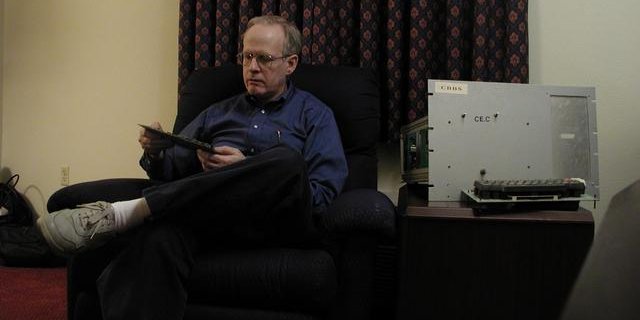
"CBBS (Computerized Bulletin Board
System) was a computer software program created by Ward Christensen
[above] to allow him and other computer hobbyists to exchange
information between each another. In January 1978, Chicago was hit by
the Great Blizzard of 1978, which dumped record amounts of snow
throughout the midwest. Among those caught in it were Christensen and
Randy Suess, who were members of CACHE, the Chicago Area Computer
Hobbyists' Exchange. They needed some quiet time to set aside for
[their] project, and the blizzard gave them that time. Christensen
worked on the software and Suess cobbled together an S-100 computer to
put the program on. Christensen and Suess described their innovation in
an article entitled "Hobbyist Computerized Bulletin Board" in the
November 1978 issue of Byte Magazine." (Wikipedia)
Other points to note
- Franklin
In this issue we are also reminded that other heroes exist who
can take some of the slack. This would be a good time for Reed
to lighten the super hero load and pay more attention to
Franklin, right?
- Technology
The technology that lifts the building appears to be the same
as that used by Doom (and delivered by Namor) in FF4. The
original was lost in the ocean, but Namor has long since been a
friend so may have brought it back for study, or perhaps it is
part of standard alien space technology.
- Buscema's cover
This cover illustrates why I respect Buscema as a superb comic artist,
but he is not my favorite. He freely admits that he is not interested in
superheroes. On this cover he wants to show the Baxter Building flying
into the sky. Here are his pencils.
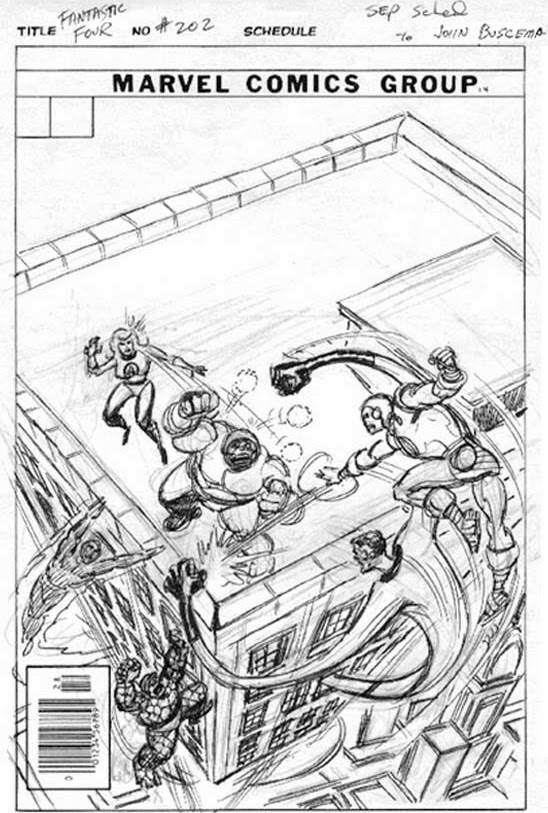
It's not obvious at first that it's flying, but look for a while and you
can tell. But unfortunately this building cannot possibly be the Baxter
Building: it's far too small (and the windows are wrong, but those are
easy to change). When you make the roof big enough then the image is
ruined: it draws attention away from the most exciting part, that the
building is soaring into space. Unless you focus on the bottom third it
just looks like people fighting in a school playground.
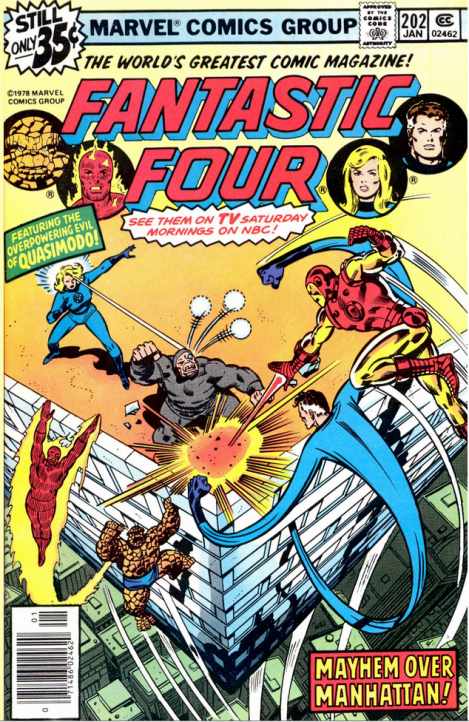
Which is a pity, as this is a pretty dramatic and important event.
A12
Annual 12: the beginning of the end
Do not be deceived by the light hearted start of the story,. The
second half is the start of something big.
The splash page to this issue announces "The end of the Inhumans... and of the Fantastic Four;
possibly the most powerful story you'll read in this, the Marvel
renaissance of comics!"

Historic events in this issue:
- Luna is (probably) conceived: see the notes to FF 240 for details.
Along with Franklin, she may be the while reason the FF got their
powers, the whole reason fro the Kree engineering the human race in the
first place.
- The beginning of the Sphinx saga, which leads to the end of
the FF and the end of the Inhumans as know them
- The reawakening of Johnny's love for Crystal, which will
eventually lead to a new
Fantastic Four.
- Reed begins to show humility: he admits that the name "Mr
Fantastic" reflects a certain immaturity.
- Sue begins to assert herself, and for the first time she
treats the men like children. (This is only fair: when presented
with an invisible force field they were idiots not to
immediately call on Sue.)
- We learn that Black Bolt's power source is almost infinite.
The sphinx considers him one of the most powerful beings in the
universe. Clearly there is more to Black Bolt than we realize.
- We see Lockjaw's true abilities for the first time, saving the
world and perhaps the galaxy. Usually Lockjaw is careful to
pretend to be just a foolish dog, but for the first time his
true intelligence and ability are plain to see. personally I
consider him to be the world's greatest
super hero.
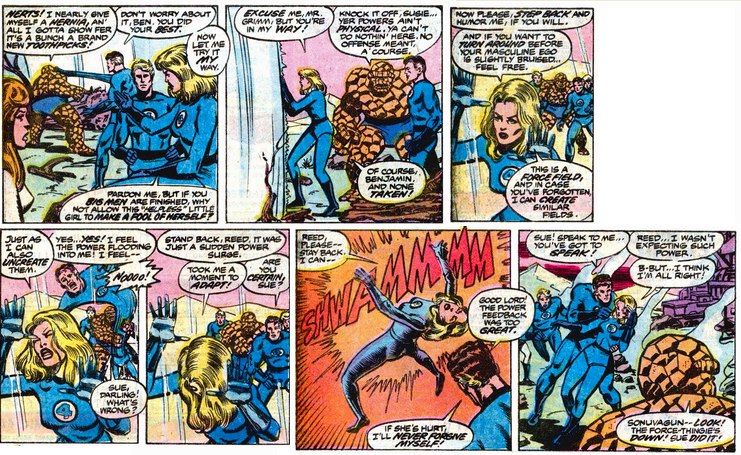

The sphinx and the end of FF
The Sphinx plays the long game. He always reminds us that he's
five thousand years old. He is named after a being famous for
riddles, his power is of the mind, and his quest is for knowledge.
He caused the end of the Roman empire:a process that took
centuries. He is seeking a way to die, but we should not expect to
understand the full scope of his plan.
In this issue the Sphinx is seeking ultimate answers from the
brains of all humanity. Black Bolt defeats him and sends him away,
so he simply looks in a different place: we next see him in FF206,
looking for the brains of Xandar: it's all the same quest. That
story involves the apparent death of the FF, and while they do
survive, it affects Reed's self confidence so much that he finally
retires (in act 5). The first team then ends and another begins,
so yes, the sphinx caused the end of the FF.
The sphinx and the end of the
Inhumans
This story continues in FF204-212. The Sphinx continues his search
for the collected knowledge in billions of brains. At the same
time, a secretive group kidnaps Medusa (at the end of FF207). What
better way for the Sphinx to get back at Black Bolt? That group,
the enclave (last seen in FF67) then attacks the Inhumans (in
FF240). This attack causes the Inhumans to leave Earth, ending
hundreds of thousands of years of earth-bound civilization
(compared to the Inhumans, the six thousand years of human
civilization is just a temporary blip). At the same time, Crystal
is pregnant. This is the first mixing of Inhuman and human genes,
and end to the Inhumans' genetic purity. genetic purity was
central to the Inhumans' culture, so nothing would be the same
again. These two events, leaving Earth and ending their genetic
purity, constitutes the end of the Inhumans as we know them. It is
also likely that the eventual union of Crystal and Johnny will
lead to a merging of Inhuman and Human civilizations. FF annual 12
deals with both topics: the Sphinx's interest in defeating the
vastly powerful Black Bolt, and the love of Crystal for both
Quicksilver and Johnny. As such, FF annual 12 is the key to
understanding the end of the Inhumans as a we know them.
Objections to the Sphinx being
involved in FF240
- Where is the evidence? On the surface the attack is caused by
Maximus, just as in this annual the attack seems to be caused by
Thraxon. But in FF240 the attack is just a distraction from the
real problem: a plague. Who do we know who uses plagues to end
empires? The Sphinx.
- But the plague was blamed on pollution? Then why did it
suddenly hit when the Enclave attacked? Somebody is influencing
events.
- But the Sphinx by FF240 was condemned to relive his past life
endlessly (see FF212)? That just gave him plenty of time to plan
for his revenge from "beyond the grave."
The war of Three Galaxies
The sphinx's plans are part of the war of three galaxies. This was
the subject of the Inhumans own comic (12 issues, bi-monthly from
1975 to 1977). It built to a climax in issue 12, when we first saw
Thraxon, indicating that the Sphinx was deeply involved. Though
the Sphinx had his origins on earth, his knowledge and power means
he will quickly become involved in the galactic battles that rage
around us.
The war of three galaxies continued in Captain Marvel issue 53,
but the ending was far too simple for such a major event.
"Using the Chair of Truth, Mar-Vell is able to expose Par-Bat as a
Skrull, intent on forcing the Kree into a war they can't win. With
his infiltration exposed, the war is successfully prevented." (source)
Would any multi galaxy war end simply because a single spy was
uncovered? It is far more likely that the war was simply driven
underground. It is part of the Kree-Skrull wars that continue for
decades across countless star systems.
Why is the war of three galaxies not explained more clearly in
the comics? Because only the Fantastic Four report directly to
Marvel Comics, so all other comics are either made up or pieced
together from imperfect clues. The war of three galaxies was
largely a secret plan that only affected the Fantastic Four at the
margins, so Marvel Comics would have very little knowledge of what
was going on. We only see fragments of the much bigger whole, and
Earth is just a tiny outpost, not the center of the action.
The end of the Skrull empire
I am not going to try to piece together the full scale of the war
between three galaxies, that would take a better mind than mine.
But I will note that the Sphinx arc in FF206-210 caused a power
struggle in one corner of the Skrull empire, and power struggles
like that eventually caused that empire to make piece with its
rivals the Kree (see FF annuals 18 and 19). The other decisive
feature in the Skrull-Kree peace was the destruction of the Skrull
throne world by Galactus. This story with the Sphinx ends in a
show-down with Galactus. Could it be that Galactus absorbed some
of the Sphinx's purpose? Galactus is, after all, a force of nature
(see FF262), and forces can be guided.
The war of the four cities
This cosmic epic must surely be also linked with the Jonathan
Hickman's "war of four cities" (FF570-604 and beyond), a cosmic
battle involving the Inhumans as key players. This is part of the Great Reboot that gradually
ends and restarts everything. However, all of that takes place
within the confusing complexity of the Franklinverse. It would
take a better man than me to untangle all the details.
Why does Annual 12 come after
annual 13?
The Marvel Chronology Project places this annual between FF200 and
FF annual 13, but this is highly problematic. Annual 13 begins
with Johnny being overjoyed that the team is back together in
FF200. If FF annual 12 has to squeeze in between the two events
then this makes no sense. So when is it set? Is it just a very old
story?
- It cannot be set between FF173 and 200 because Reed has full
stretching powers.
- It is unlikely to be set between FF166 and 173 because Reed's
stretching was limited, plus Ben wore a mechanical suit, and
neither is referenced.
- It cannot be set before FF159 because the Inhumans' city was
normal then (and before F150 Crystal was not married).
- It might be set between FF160 and FF165, because Reed's
concern with tax money would have been high before they
incorporated in FF161, but that leaves an extremely narrow
window for Thraxon to overthrow the Inhumans' land.
- An early date also cause problems for Johnny and sports cars.
Though he tinkered in the early 1960s he barely touched them in
the 1970s until the team broke up. He took up serious racing
after FF190.
- The story leads directly to FF206 so it is natural to place it
just before that arc began. The Sphinx may have needed a little
time to prepare, so I opt for placing FF annual 13 between FF203
and FF204.
It may seem odd to publish a later story (FF annual 13) first, but
annuals 12 and 13 happened very close together, and annual 13 was
very clearly after FF200. The only real problem is how Marvel Comics
knew about the event in time to publish it a year early? (FF annual
12 came out at around the time of FF188). The simplest explanation
is that so much happened in the lives of the FF that Marvel had a
one year backlog of stories: annual 12 was published as soon as it
happened, because it suited an annual, and other event waited until
the backlog was published first. This explains why the splash page
used such hyperbole: the story was a glimpse into important events
that would not be shown in the comic for another year.he characters
themselves are of course unaware of story backlogs and gaps between
issues: Marvel Time means they experience far less time than we do.
Criticisms
The Sphinx is sometimes extremely powerful, and other times
struggles even to control four beings plus the ship? He is the
sphinx, named after the creature who set riddles. His power is of
the mind, and he is obsessed with data: he does not work in the
same way as simple physical power, though that power can sometimes
be harnessed. This foreshadows modern computers: in some ways a
computer can harness great power (e.g. to run a machine), but if
you attack a computer in the right way even a child can defeat it
(e.g. by turning it off).
Other points to note
- Johnny refers to racing driver A.J.Foyt:
Foyt won the International Race of Champions all-star racing
series in 1976 and 1977.
- The first half of the issue may appear to be played for
laughs: it has silly jokes and a very corny villain. But the
jokes reflect the appearance of the Gong
Show, and the corniness of the villain is the whole point:
the Sphinx chose the stupidest man he could find, to distract
from his deeper purposes.
- This is the only issue (along with the recap of the same
origin a few issue later) to
feature an actual character from the Bible: Moses appears
in the origin of the Sphinx.
- Contrast the original Sue's dislike of a revealing costume
with the new, different Sue
who wore even less.
- The original sphinx's most famous riddle was "what walks on
four legs on the morning, two legs in the afternoon, and three
in the evening?" This riddle could apply to the FF:
- At first (act 1) they were all equal, so the team rested on
four pillars, the four members.
- Then Reed marginalized the others, but despite that, Ben was
often referred to as the strongest member, and he was the only
one who was popular enough to support his own title (act 4,
when the team rested on two members).
- Finally Reed's influence, declined so all the original
members were equal. But Ben left the team and She-Hulk was was
only a temporary fill-in, so the team rested on three members
in the evening of its life.
203
Issue 203: "the then-classic, now a woefully underrated story"
This classic of the zeitgeist (see below) also completes the
clues for Franklin' powers. It thus foreshadows the next 100
issues.
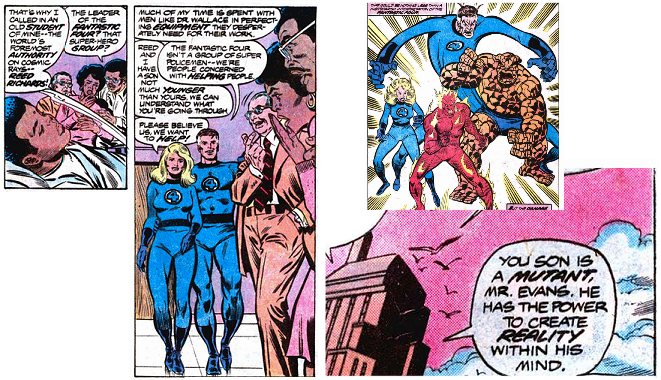
Foreshadowing the next 100
issues
We have had the false dawn, now we get a big reminder that this
story is all about Franklin. Let's run through what Reed knows
about his own son:
- He knows his son has vast cosmic power (FF241)
- He knows his son can save them when the combined force of
Fantastic Four, Inhumans and Avengers cannot (FF250)
- He should know that his son can unconsciously control others
(FF134).
- He knows that Sue thinks they should spend more time with
Franklin, and her intuition is never wrong.
- Now he gets another big hint: here is another boy, about the
same age, also affected by radiation before birth, and able to
unconsciously bend reality to his will.
Reed is supposed to be highly intelligent. If only he paid some
attention to his own son he might come to some interesting
conclusions.
The Great American Mystery novel
Although Franklin's nature and power are not obvious until the end
(Heroes reborn in 1996 shows his universe creating power, and
FF600 reveals that Galactus is his herald), by this point we have
sufficient clues: here the Great American Novel is a detective
story where the reader can see what the detective cannot. Reed
lacks the self awareness to see his weakness (his need to
control), and he lacks the humility to see that Sue's intuition
(to put Franklin first) is just as important as his own scientific
skill.
Note the overarching theme of Franklin: he will dominate the story, directly or indirectly, from now until Byrne (FF322).
The Zeitgeist: against tokenism and unintentional
racism
This issue marks a notable move away from "token black
character":
Willie
Evans was notable because it defied so many expectations and
stereotypes regarding minority characters. As a black guy, I
remember me and many of my black friends used to notice about
how black heroes were all either stereotypes (Luke Cage’s jive
talk), inferior sidekicks, copies of established white heroes
(Rhodey, Jon Stewart), or underpowered (Black Panther, Falcon),
or obvious cannon fodder to get beat up or killed or taken
hostage in fights. Willie Evans was a pretty unique character
for his time and defied a lot of stereotypes. If I remember
correctly he was middle class rather than ghetto. He was
ridiculously overpowered. He was not a copy of a white hero. He
wasn’t inferior to the white heroes in the book. -("T"
commenting on comic book legends)
Willie was intended to be part of the new X-Men (see below) but
that idea was quashed. Instead he was brought back in Iron Man
annual 8, revealed to have killed his mother, and died. For me,
this illustrates again why the Fantastic Four was better than
other comics. "T" speculated that the Iron Man story is probably
why the Willie Evans story lost its importance over the years. He
continues:
"There’s
the possibility of unintentional racism at play[. ...] For him
to then just be reduced to cannon fodder like many black
characters in predominately white stories not only undoes all
those groundbreaking aspects, but does it in one of the most
stereotypical ways possible. So now, whenever you bring up the
original groundbreaking story, one also has to bring up in the
following breath the super-stereotypical way he ended up." (ibid)
This tension between awareness of tokenism, but the mainstream
still treating black characters in stereotypical ways, is a
reflection of the spirit of the times. People were now aware of
the problem but not yet able to deal with it. The Iron Man story
may explain why FF203 is no longer treated as a classic.
Symbolism
- Inner battles
Reed is fighting against
himself, just as Doom was in FF 199. Doppelgangers are a recurring motif throughout the 27
year story: All of his battles against Galactus and other dangers
are really battles with himself: because they are a direct result
of Reed not paying attention to his child (or before 1968, of not
paying attention to his family). Franklin could solve all his
problems if only Reed noticed his own son. The biggest danger of
all, Galactus, is in fact his son's herald! - Lady Liberty
The Statue of Liberty often appears in the Great American Novel (see the notes by the cover to FF1). It appears again
in the next issue, when Johnny breaks free and tries for independence.
Liberty is the central theme of American existence: see the notes to
FF200 for example. In both cases, liberty is an inner battle: we are
never seriously threatened by outsiders, we are threatened by
ourselves.
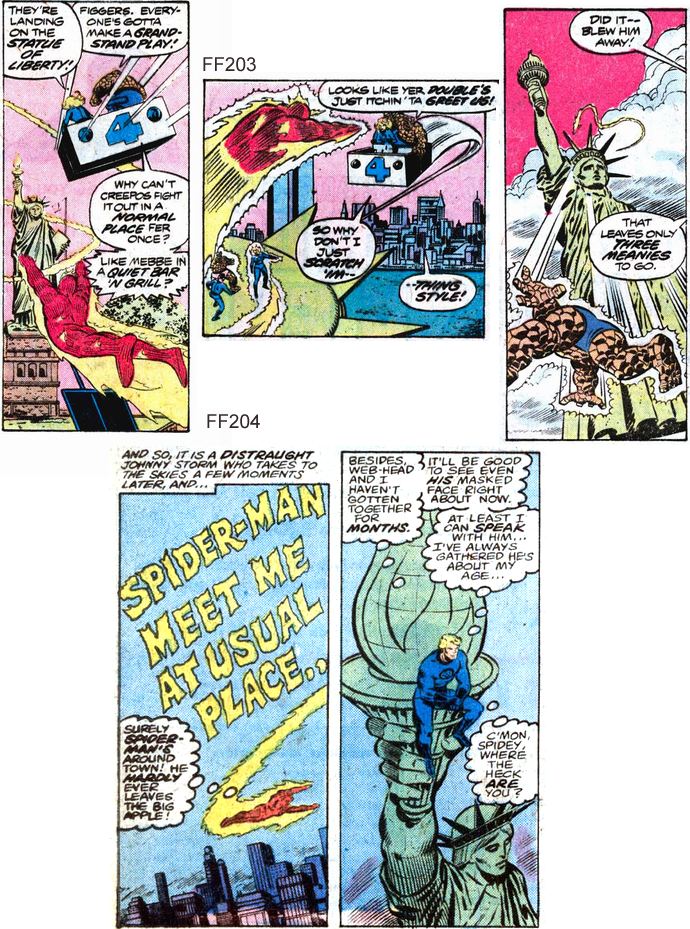
- The old flying bathtub
This is an attempt to start again. Byrne will try this one last time, pushing it as far as it can go.
Other
points to note
-
"The then-classic (now a
woefully-underrated story)"
Brian Cronin (of Comic
Book legends) refers to this as "the then-classic (now a
woefully underrated story)". Years later when Byrne referred
to “that black kid from FF 203" everybody knew the issue he
meant. Cronin continues, "That issue of FF was a big deal.
Everyone would know what Byrne meant. But for whatever reason,
the issue has lost some of its acclaim over the years. I dunno
why." For a possible reason see the discussion of the
zeitgeist and racial sensitivity.
Marvel Time and Franklin's
age
Willie Evans Junior is nine years old (this comic is on sale
in 1978), and his father was affected by cosmic rays in 1968,
and then is told to call Reed Richards. The parallel with
Franklin should be obvious. As should the fact that Franklin
was born first, yet appears younger. Something is slowing down
time around Franklin, while time runs at the regular speed
elsewhere. Occam's razor (use the minimum necessary
explanations) suggests that the being who slows down
Franklin's aging is Franklin himself. After all, Franklin gets
part of his power from the cosmic control rod that gives
Annihilus immortality.
-
Willie in the X-Men
Willie Evans was originally planned to be in a new X-Men team,
along with Kittie Pride, and a character called Caliban (not
the same Caliban who later appeared).
"(Editor-in-Chief) Jim Shooter killed the concept of a
second team of X-Men, the X-Men in training, because he said
it sounded too much like the Legion of Substitute X-Men, so
it died right there and Kitty became the only one who ever
made it into the book,” Byrne revealed in The X-Men
Companion. “Kitty, Caliban, and Willie Evans, Jr., that
little black kid who was in Fantastic Four #203 (1979), who
made the monstrous version of the FF, were the only ones we
were sure were going to be in it.” (source)
Despite squashing the idea, Shooter later revived the idea as
the New Mutants. John Byrne, never a fan of Shooter (to put it
mildly), was not impressed.
"Willie Evans was killed in Iron Man Annual #8, which also
featured an early guest appearance from X-Factor. So there’s
some weird, likely unintentional symmetry in a character who
at one point was going to feature in the first X-Men spinoff
being killed off in an issue featuring the characters from
the second X-Men spinoff." - (source:
Teebore)
- Franklin's wife:
Johnny observes that Sue can bake cookies in ten seconds. He
asks what Franklin's future wife will do to impress him. Well,
Rachel, daughter of Phoenix will do a lot more than bake
cookies.
- About those eyebrows...
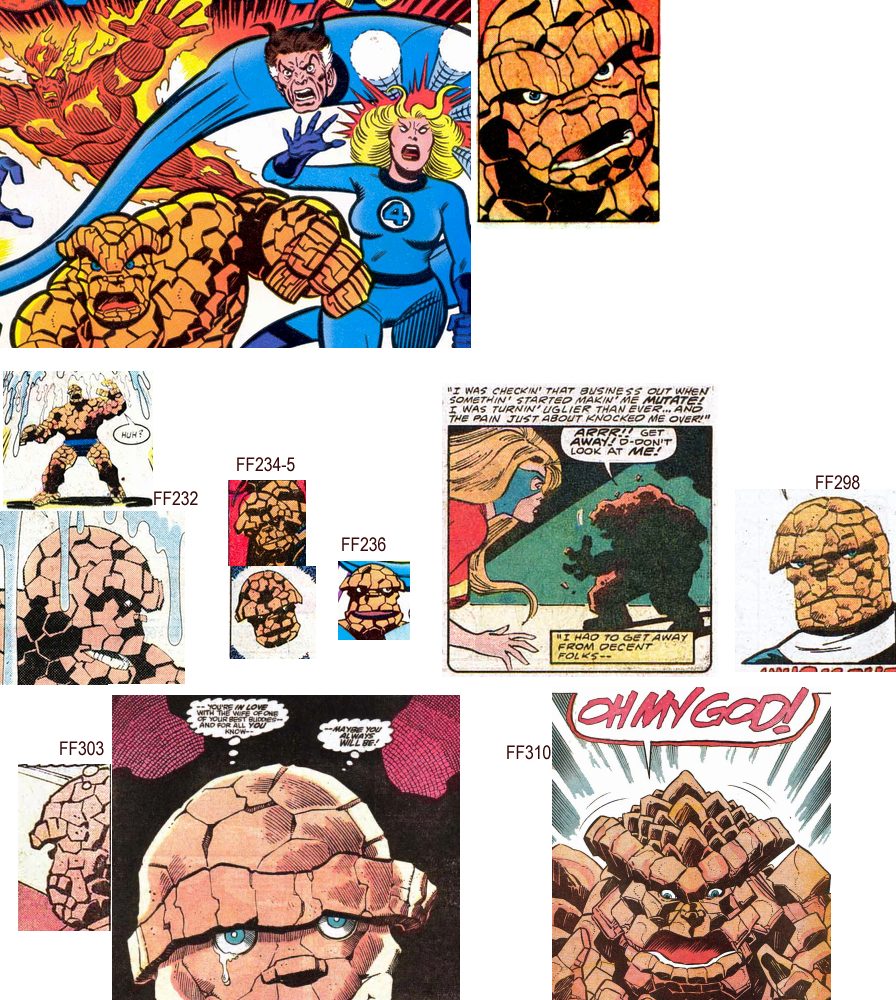
In FF232 John Byrne will take over, and the Thing will lose his
distinctive eyebrows. We see in FF203 that the extreme eyebrows
are a sign of evil. John Byrne's run coincides with a time when
Ben has seen the others become just as depressed as he is, and he
appears to mellow. The stress that twisted Ben's face softens and
his eyebrow softens.
- Early in Byrne's run Reed tries again to "cure" Ben and Ben
loses the eyebrow completely for a while.
- At the end of Byrne's run, Ben sees Alicia marry Johnny, his
inner stress goes into overdrive, and Ben's entire body
distorts.
- Being accepted by the Mole Man lets him relax enough to soften
again.
- It is possible that his face is still changeable, and this
would explain why he prefers to wear a mask for a few issues
until it settles down.
- He then had a brief moment of extreme stress at the end of
FF303 and his brow briefly became very pronounced again.
- The almost-final major change was in FF310, where the pressure
of being leader led to a more extreme all-over eyebrow effect.
- But then the final change occurred: the change inside, when he
realized that he had never been ugly. He is the idol of
millions, and his appearance is great! No doubt had the series
continued he would have gained the ability to his previous human
form at will, just as he could on Battleworld.
The second half of act 4:
Franklin
As we enter the second half of the fourth act Franklin begins to
dominate:
- FF203: Another clue that Franklin is the key
- FF204-214: The longest arc, where Reed is the helpless child:
it starts with Franklin, and ends with Franklin's herald, then a
pointer to the next generation.
- FF215-218: more clues that Franklin is the key
- FF219-231: (the Doug Moench run) all about Franklin
- FF232-250: more clues, and disaster piles on disaster, until
Reed finally learns humility.
- Act 5: Reed decides to put Franklin first.
The Great American Movie
The Great American Novel is like the classic Hollywood movie
(think ET, Finding Nemo, Up, etc.). It's really about a father
making time for his son. It's about Reed and Franklin.
204
Issue 204: the truth about Johnny's love
life
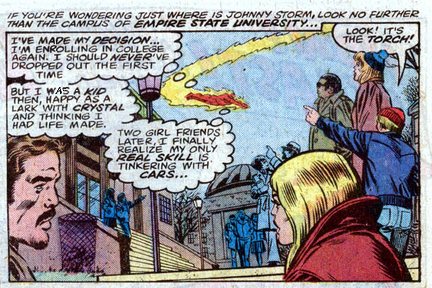
This is the issue where we learn the truth about Johnny's womanizing
reputation: it's all an illusion. he only had two girlfriends since
Crystal, which means his entire experience with women is:
- Dorrie Evans in high school
- Crystal
- Frankie Rae
- Lorrie Melton
That's it. Plus a few very short dates in his teenage years that
didn't get anywhere. And every girl ended up dumping him.
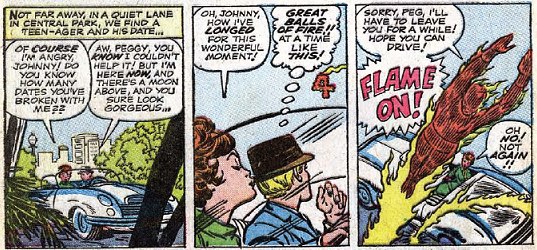
In annual 19 Johnny tried to claim that Julie d'Angelo was once his
girlfriend, but that just reveals Johnny's desperation. Follow the
issues closely and you see that the only time she was with Johnny she
had her girl friend along. He boyfriend was Gray landers, not Johnny.
Cars and the Great American Novel
Apart form highlighting his love life, this issue does something else:
Ben reminds us that Johnny spends most of his time in the garage.
Psychologically this is interesting: he feels powerless in the team and
in his love life. Cars are the one area where he can always succeed. The
idea of cars as compensation is so well known that it is a
psychologically cliche.
Cars are a major part of American culture: other nations can easily
look at America's need for big cars as a symbol of the nation's need to
thump its chest: American stuff has to be bigger and better, and cars in
particular are symbol of freedom.
Redheads
This issue is full of American symbolism: the cars, the statue of
liberty, pinball machines, etc. Critics point out that more modest
nations might be more free and have better quality of life: the usual
example is Scandinavia, with its bicycles and social safety net, and
northern Europe in general. Frankie Ray can be seen as a symbol of these
outsiders: she is a red head (reminding us of northern Europe), and not
impressed in the slightest by Johnny's all American offering. The name
"Frankie" is etymologically from the Franks or French: the allies who
are most critical of America. And of course the statue of liberty was a
gift from France. Frankie's surname, Ray, is a counterpart to Johnny's
flame and reminds us of the rays on the head of Lady Liberty.
The longest arc in the entire
28 year story
FF204 begins the longest arc of all: the skrull aging storyline.
This is where the last bricks of Reed's psychological support are
removed:
- Reed fails as a leader: it's a series of failures, disaster
after disaster.
- Reed fails as a scientist: he can't solve the problem, until
he is almost dead and Johnny helps him. True, he does solve the
technical problem at the end, but nobody ever doubted his
technical skill. Reed only fails as a scientist when he tries to
combine with leading the team: he could not fix the gun until he
lay down and let Johnny do the fighting.
- His health fails him. He grows old and dies (or as good as),
with nothing to show for it.
- It is a small step from there to literally losing his mind in
FF255.
Before the end of the novel, Reed must lose everything.
...and it all starts with
Franklin
It starts of course with Franklin. the significance of this
arc is that all the suffering is not needed: Franklin could solve
the problem! Or he could have, if Reed had paid attention to his
own son.
Note the perfect symbolism of the splash page for this 11 issue
arc:
- Franklin is at the center, in control.
- Johnny is at the top, waiting to one day take over, but held
back.
- Ben is held down, frustrated (he is not physically hurt, so it
must be his pride). This is not his son,yet he is the only man
who pays Franklin any attention.
- Reed has his back to Franklin and to his family.
- Sue serves and is ignored.
There is the whole 28 year story, right there. To drive
home the point Reed's friendly witch takes Franklin away, Sue
tries to persuade Reed to pay more attention to their boy, but
Reed won't even look at her. Sue is in despair. Over the next 11
issues Reed will pay a high price for his neglect.
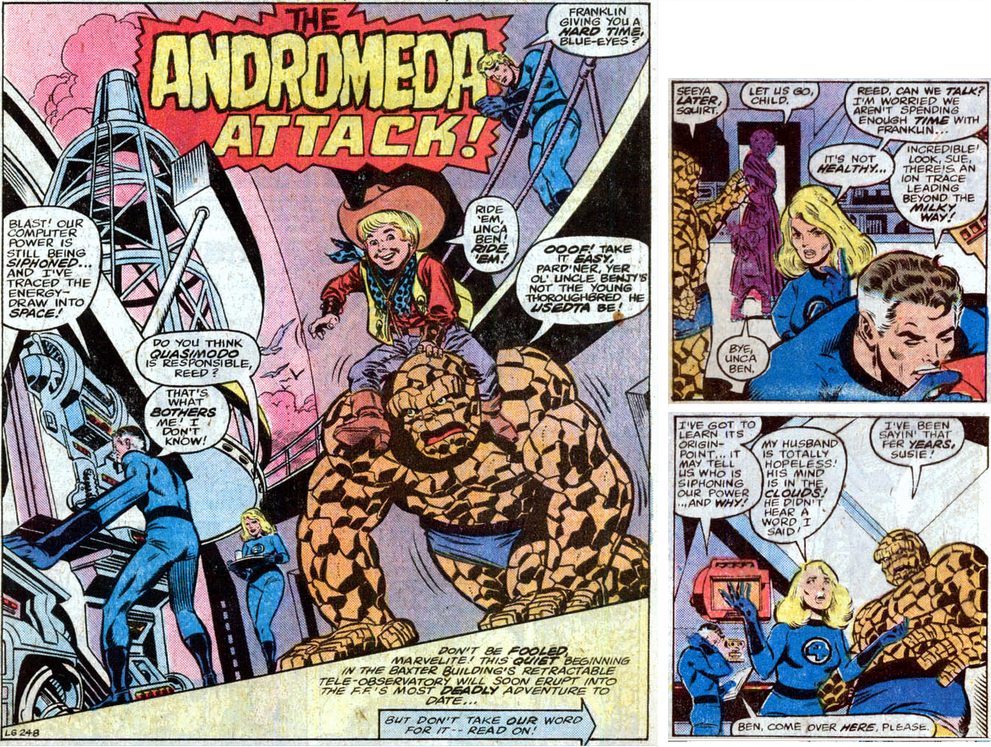
Note the irony that Reed won't listen because he is concerned
that something is siphoning their power. On a larger scale it's
Reed's inability to listen that's really siphoning the team's
power.
The title "Andromeda attack"
Andromeda is a legend about hubris, and the origin of the
"princess and the dragon" motif. In the original, Andromeda is the
princess, chained up to be eaten by a monster. "When [queen] Cassiopeia's hubris
leads her to boast that Andromeda is more beautiful than the
Nereids [sea nymphs], Poseidon [powerful god of the sea] sends a
sea monster to ravage Aethiopia as divine punishment. Andromeda
is chained to a rock as a sacrifice to sate the monster, but is
saved from death by Perseus [the archetypal hero], her future
husband." (source)
In the Fantastic Four version,
- Princess Adora plays the part of Andromeda
- The Skrulls are the dragon.
- She is there because of the hubris of her mother world: it
claimed to have more advanced science than anybody else. If that
was true then it would surely know about the skrulls and be able
to repel them. But it must have been an empty boast: it was
enough to attract the skrulls who destroyed the world.
- Who plays the role of Poseidon then? We don't know the whole
story, but it may have been the Sphinx. See the discussion of
the war of three galaxies, in the notes to FF annual 12.
Xandar's boasting attracted his attention, so he may have
prompted the skrulls to attack. This is just speculation.
- Who plays the role of Perseus? It is strongly hinted that it
is the Watcher who saves the planet from complete annihilation.
Like the Sphinx, the Watcher works in secret, so we have to
piece it together from clues.
What does this have to do with the Fantastic Four? It is a story
of hubris causing catastrophe. The real villain in the Andromeda
story is not the dragon or Poseidon, but queen Cassiopeia who
thinks she is praising her child but instead puts her in danger
through her stupid boasting. Similarly, Reed causes his own
problems by not caring enough for Franklin: he thinks he is saving
everybody but just makes matters worse.
Is Sue queen Cassiopeia?
Here's a radical idea. Possibly Sue is actually most at fault.
Reed may be autistic - he may have genuine difficulty in social
interaction with his son. But Sue is balanced, sensitive,
intuitive. She sees the big picture. She could take control if she
wanted to. She could solve everything, But she is happy to play
the submissive role, it's safer. By doing this she supports Reed's
arrogance. Reed does not realize he's arrogant. Sue does: perhaps
this means that really Sue is the arrogant one? That Sue is
Cassiopeia, the one who causes everything, the power behind the
throne, but like ancient queens she pretends to be submissive? In
chess it's the queen who has the real power to move. Is Sue
Cassiopeia? Just a thought.
This arc in context
It may help to see this arc in context of the longer subplots of Act
4:
- Reed loses everything except his pride (103-195)
- The false dawn (196-203)
- Reed's science and health fail him (204-214)
- the team despair (219-231: Doug Moench)
- back to basics (232-250: John Byrne)
- Reed is finally humbled (251-294: John Byrne)
Beyond the question of Franklin, this arc is a reminder that:
- Time must move forwards (see also FF288)
- That characters do age,
- And that the future belongs
to Johnny.
Other points to note:
- Sue's methods
Note the central comparison in the 28 year story: unlike Reed, Sue puts the family before work.
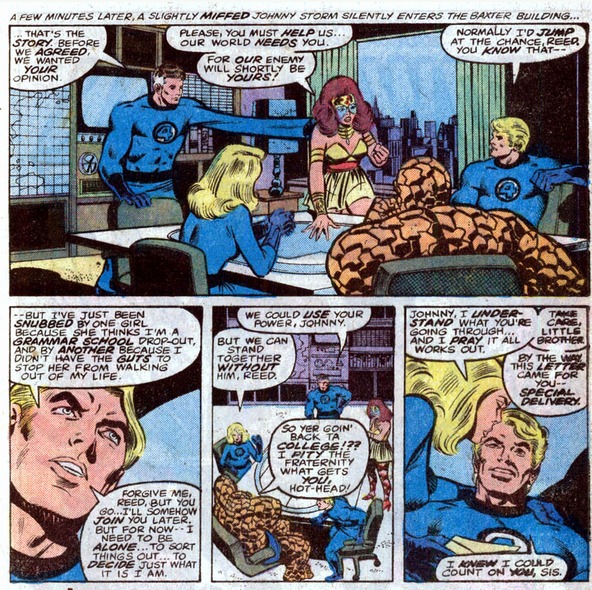
- Nova
Why will this arc feature so much Nova? Because at the time Marv Wolfman, writer
of the FF, was also writing Nova, and planned
to have half of the story in each book. Then suddenly Nova
was canceled, so the entire epic took place in the Fantastic
Four. See the notes to FF206 for more details
- Aging
This skrull aging ray arc is also about the futility of
resisting change. On the surface it might seem to say that aging
is a bad thing. But if Reed had embraced aging earlier, and
accepted his role as a father, he would have had Franklin to
solve all his problems. Instead he just aged, failed at all his
attempts to fix things, and ended up looking like a fool until
the youngest member of the team saved him. Again, see the notes to FF206.
205
Issue 205: how to fight overwhelming odds
This issue is where Reed fails embarrassingly: only Franklin
could fix this, and Reed refuses to pay him any attention.
The team is battling an entire Galactic empire.
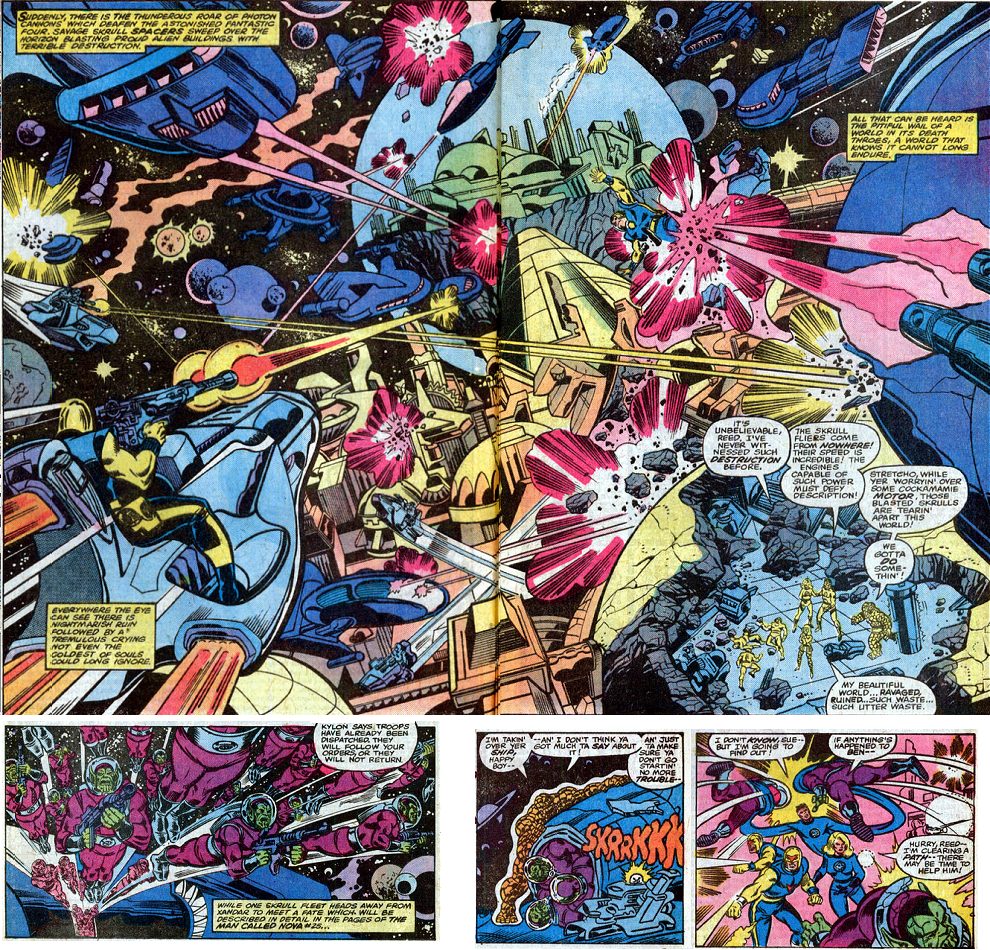
They fight a few Skrulls at a time: banging heads together,
rolling them up in a steel trap, etc. Hitting them and rolling
them up is futile: these are shape changers! And there are
probably billions of them: soldiers from countless worlds! Reed's
method shows he has no idea what to do. The Watcher can see that
it's hopeless. Yet back home, Reed has a son with almost unlimited
power.
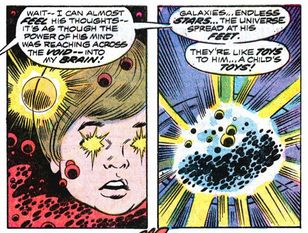
The last time that the combined forces of all super heroes failed
(Fantastic Four, Avengers, Inhumans, etc.), Franklin stepped in
and solved the problem.
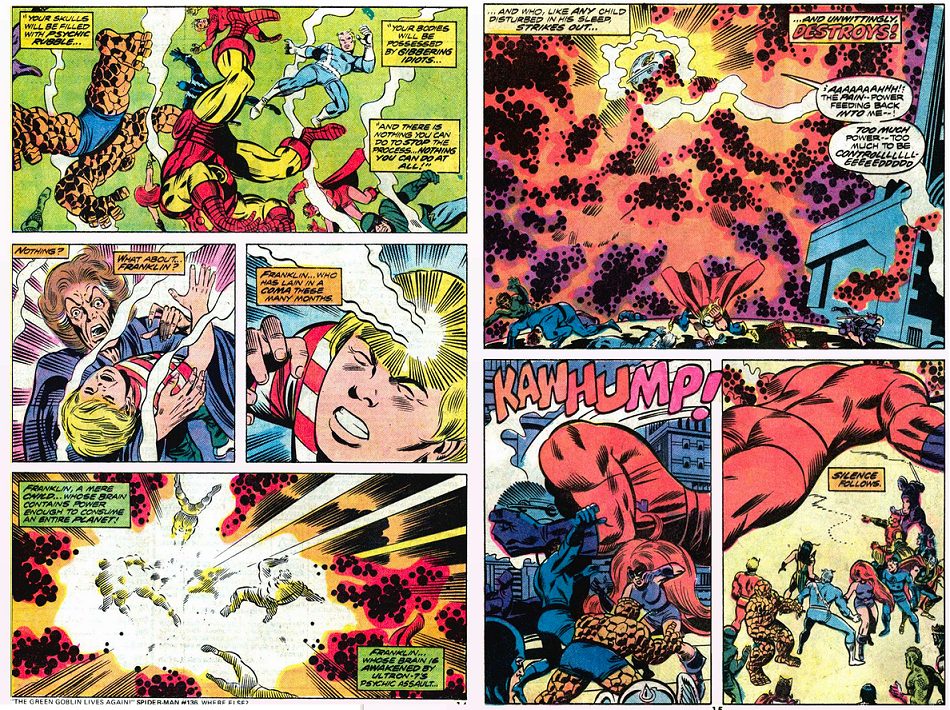
The answer to this war was at the start, on pages one and two of
this arc. Franklin is the answer. Reed just can't see it. He is
too busy playing the hero to see the potential in his own son.
Other points to note
- Inequality:
In the sub plot, note the celebrity culture and rise of high
security luxury schools for the rich and famous. These were
rising in visibility in 1979.
- Blindness:
The Monocle preys on Johnny's insecurities: ironically the one
eyed man, the man who makes others follow blindly, will trigger
the self reflection that will cause Johnny to see clearly and
finally lead the others.
- Reed's decline:
Reed's mind is so confused that on Xandar that he doesn't even
appreciate the power of computing: he doesn't agree that
knowledge can be better than violence.
- Sue as strategist:
Normally Sue is very cautious, but this is due to her wisdom, not
cowardice. On age 26 Sue disagrees with fighting a *defensive* battle.
she wants to take the battle to the throne world. A few months
later her son, unconsciously acting through Galactus, will do
exactly that by destroying the skrull throne world. Compare
Sue's desire to take the battle to the skrulls with her similar
plan when her father was killed. Sue has always been the bravest
one: while she is the one most aware of the dangers, and the one
who prefers to cooperate and leave alone most of the time, she
is also the most willing to take the fight to the heart of the
enemy when needed. In contrast, the boys have a one note modus
operandi: they just fight what they see.
- Other superheroes are less important
In this web site I argue that other Marvel characters are generally not
as powerful as their own comics suggest. Here we are told that "soon,
twin forces will be unleashed which shall bring the very universe to the
brink of annihilation" yet other heroes are not considered relevant
(apart from Nova, as he has links to Xandar). The Watcher says the
universe depends on the other three, and on one youth "who must face his
mortality before voyaging on the endless cosmic seas". No other
superheroes are mentioned, they don't count in the bigger picture.
206
ISSUE 206: THE DEATH OF THE FANTASTIC FOUR
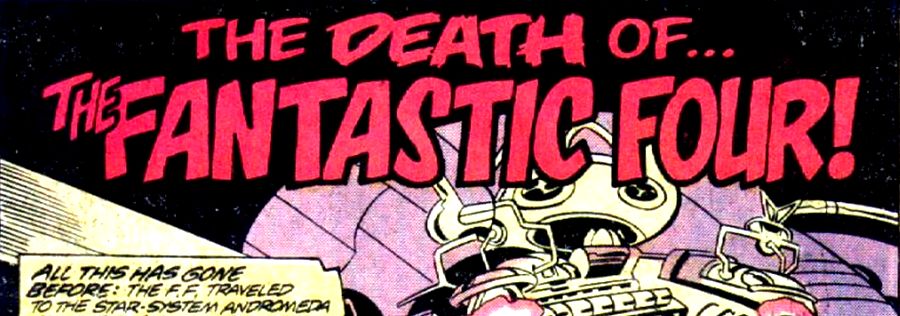
In terms of comics history, this is possibly the second most important
issue after FF1. FF1 saw the origin of the Fantastic Four, and this
issue is the beginning of the end. Here the writers begin to embrace bad
story telling. They lie to readers, and devalue the story. This issue
sees the beginning of the revolving door of death.
Why FF206 is the key issue
FF206 is the first time
that death was used as a gimmick. The poster
child for gimmicks is dying, then coming back to life. This had never
happened before: with the FF, death mattered. When Franklin Storm died it was real. When Desmond Pitt
died it was real. It meant the dangers the team faced were real. But
when death is no longer real the dangers don't matter any more. Why care
about danger? If you die you just come back. The story no longer matters.
There were a few
cases in the past where a character thought
somebody was dead, but that was merely a character's opinion. This is
the first time the story title announced "they are dead!" with no
ambiguity. This is the first time the comic lied to the readers.
Ironically, devaluing death means the story itself is dead unless the
writers change direction. But they did not.
A one off... for now
This was
the only time the writers lied for a while, So readers could overlook
it. The rest of the story was good, and there were good stories
afterwards. But eventually lying became normal. When continuity ended in
the 320s everything became a lie: the characters spoke about danger but
there was no danger as nothing would ever change. the characters would
make some major change as if it mattered, like a change to the line up
or an event that changed the character's life. But all these things are
lies if we know they will always return to the status quo.
An unintended big story
This fake death was part of a pattern: after FF200 everything was
becoming more desperate, more extreme, less permanent. We can therefore
stand back and see a long term trend: a bigger picture to the story.
Yet the writers never intended it to be a bigger story: they were only
planning three or four issues ahead. This illustrates what this web site
is all about: writers planned a series of short stories and ended up
with a story that has a large scale structure.
How they died in the real world
In the real world, The Fantastic Four was a comic, Marvel's prestige
title. Although Spider-Man eclipsed its sales a few years earlier, it
was still the benchmark of consistent quality, a top tier heavyweight
title. That changed after FF200. While most fans agree that FF200 was a
high point in FF history, most also agree that quality plunged
immediately after. It is routinely said that the book "lost its way" and
Byrne had to rescue it.
Byrne revived the book's fortunes, but
(according to most fans, and according to sales) when he left the book
continue to decline. Fans still look back at the period after 20 as when
the book lost it way, even more than it lost its way after Jack Kirby
left. For what made Marvel great (realism) click here. For how Kirby created such great stories click here. For when it first began to go wrong click here. For the causes of long term decline click here.
The decline continued for decades. Now, at the time of writing, the book's cancellation has been
announced: FF645 will be the last issue. Obviously it will return a
year or so later, but the FF's time at the top is long gone. Just this
week (I write this in mid November 2014) the Avengers comic referred to
Avengers mansion as "the most famous landmark in New York." That title
used to be strictly reserved for the Baxter building.
The so-called "problem" of aging
FF206's
"death" was reversed in FF214 by reversing the aging ray. The writers
planed it this way, in order to keep the characters young. But eternal
youth causes far more harm than good, as
the Sphinx discovered. Writers think they can recapture the excitement
of the past by avoiding change, and they fear that change will mean
characters become old and retire or become less interesting. Both ideas are false, for reasons discussed here. Instead, let us see what could have happened if the team had continued to follow the winning formula, and continued to evolve and change as they did in the 1960s:
The story telling revolution of the 1960s
The 1960s saw a revolution in story telling: the invention of stories that never end.. A number of wildly
successful franchises began that are still raking in money today. For example:
- 1960: Coronation Street
This British soap opera showed that a prime time soap can
last forever as long as it is based in everyday realism. there was also a
strong theme of happy humor mixed into the grim and gritty: these were
basically nice people. Later Australia
discovered the same formula with Neighbors (1985-present). In
contrast,
American prime time soaps were about wealth and gloss, and only lasted a few years each: people could not relate.
- 1963: Dr Who
By allowing regeneration this became the
longest running sci-fi show of all time, and one of the most successful.
Unlike most sci fi it is optimistic: the doctor never uses a gun, he
solves problems through being good and being clever.
- 1966: Star Trek
In the 1980s "the next generation" introduced the
idea of new characters taking over. Although recent movies have tried
rebooting, it is only to prevent the stories going too far from our own
experience. According to fans, Star Trek's success is down to two
things: people we can relate to (especially Kirk and Spock) and a
message we can relate to: our near future can be better than our
present! These people are in effect our children, discovering better and
greater things.
- 1961: The Fantastic Four
The FF began the same way, embracing change and realism, and sales soared, Then in 1868 Marvel Time began and sales began their long decline.
The real solution to aging
The real solution to aging is everywhere in nature, and on the most successful long term stories:
- Remember the past: remember it in detail, care about those people and what they did! it matters!
- Be ready to change. Pass on your spirit to the next generation.
FF206, and the 25 issue Nova story that led up to it, is all about the
need to remember and the need to change. Let's look at them in more
detail.
Why the Sphinx matters
The Sphinx is probably the most important character that everyone
forgets. He is the character behind the end of the FF and symbolizes the
futility of Marvel Time. The Sphinx's story forms a single arc from
annual 12 to FF213, and its reverberations are felt as late as FF240
(see the notes to that issue: who was behind the Enclave?). Annual 12 is
dated to only just after FF200, and it proclaims itself one of the most
important stories in the history of Marve Comics, featuring the end of
the Fantastic Four (and the Inhumans). See the notes to that issue for
why. The theme of the end continues in FF206 with the beginning of the
death of the Fantastic Four. The whole end and death arc is presided
over by the Sphinx, the symbol of the need for time to move on. He has
tried to live forever and realizes the futility of it, and all he wants
is to die, but at the end when his life becomes exciting again he
thinks he can cheat death and carry in, so he is published by having to
forever repeat his life. He is a symbol of Marvel comics endlessly
repeating the same old stories. see the notes to FF213 for details.
The Sphinx in mythology
In legend, the Sphinx is famous for a riddle about how people must
change: "what has four legs in the morning, two legs at noon and three
in the evening?" (Answer: man, from crawling to walking to using a
stick.) If mankind did not change he would not be man.
By
some accounts (but much more rarely), there was a second riddle: "There
are two sisters: one gives birth to the other and she, in turn, gives
birth to the first. Who are the two sisters?" The answer is "day and
night" (both words are feminine in Greek). This riddle is also found in a
Gascon version of the myth and could be very ancient. (Wikipedia)
Both riddles are about the need for change. If anybody did not
understand the meaning of the riddle the Sphinx would strangle and
devour them. We have to accept change.
More Greek mythology
The Sphinx features in the story of Oedipus, king of Thebes, and leads
to the play "Seven against Thebes". After the war Oedipus went to the
hero Theseus to bury the dead. Theseus was so famous that his ship was
preserved for centuries, which led to a famous philosophical question:
over the years every wooden plank and every oar would wear out and had
to be replaced, until none of the original wood was in the ship. So was
it the same ship? This is like the question of Nova: he had never been
to Xandar, yet he had the memories and powers and position of a
Xandarian warrior. So was Nova a Xandarian? This is the key to
understanding immortality. We accept that individual bodies die and move
on, but the spirit continues in new generations.
Xandar and Xanadu
Xandar is home to the accumulated wisdom of the ages. The name Xandar is
obviously based on Xanadu, the otherworldly location from Coleridge's
poem Kubla Khan, and inspiration for Shangri-la, a hidden paradise in
distant mountains. (Xandar is now more famous from the movie Guardians
of the Galaxy.) So when the Fantastic Four reaches Xandar we know that
the end of the
story is near. (The final 90 issues take place in around
year, their time. See Quicksilver's reference to "weeks" in FF240, and
the short gaps between most issues thereafter, with the exception of
Sue's pregnancy, which did not
go to full term.) So this is time for the cosmic background is
revealed (below).
The poem Xanadu was allegedly remembered from a drug-filled dream, and begins:
In Xanadu did Kubla Khan
A stately pleasure-dome decree:
Where Alph, the sacred river, ran
Through caverns measureless to man"
Down to a sunless sea.
This phrase "caverns measureless to man" are referred to when describing
the river caverns beneath the inhuman city of Attilan, itself a kind of
Xanadu in the mountains. The caverns feature both in FF 158 when
Attilan is invaded from another dimension, and 100 issue later in FF248
when the team are in a drug induced dream like Coleridge. There it
appears that the blue area of the moon has its own endless caverns
beneath, a place of hallucinatory drugs). The poem ends with a warning
that such things are not meant for man:
That sunny dome! those caves of ice!
And all who heard should see them there,
And all should cry, Beware! Beware!
His flashing eyes, his floating hair!
Weave a circle round him thrice,
And close your eyes with holy dread
For he on honey-dew hath fed,
And drunk the milk of Paradise.
The impossible dream for Marvel Comics editors is that stories can have
no consequences yet readers will care about their consequences. The
impossible dream for Reed Richards is that his family can be safe and
happy despite him ignoring Franklin and Sue.
Nova did not live up the Xandarian spirit
Somebody has to say it: Nova failed. he did not have the spirit of his
benefactor. he was given the powers and memories of one of the greatest
Xandarian warriors, but could not see beyond his old life. He stayed on
at school, as if getting a job in an office was more important than
saving the galaxy. He had enormous power but showed little curiosity:
did he experiment to find the limits of his power, and train constantly,
as Johnny Storm did? No, he only found he was bulletproof by accident.
He even lost the most important powers through lack of use: when he
became Nova he was at school and suddenly knew advanced maths. but later
he struggled at the same subject. He was not even proud or confident
enough to even tell his parents of his powers until much later. then
when he finally reached Xandar he wanted to give up his powers and go
back home (see Rom comic for details). His stories were lackluster.
Richard Ryer was a nice enough guy, but he was no Xandarian warrior.
This illustrates the whole purpose of good superhero comics: they are
not about the powers, powers alone are not interesting. good superhero
comics are about the people with those powers. The Fantastic Four far
transcend their powers. Richard Ryder did not. He just wanted to stay as
a school kid. He could not transcend his past.
Nova comic:
A symbol of the need to move on
FF206 continues from the just canceled Nova comic. Nova is the poster
child for the death of continuity. the title was created as a homage to
Spider-Man: Richard Ryder instead of Peter Parker, high school kid who's
uncle is killed, etc. Nova was fan fiction created by kids (the
young Marv Wolfman and Len Wein in the fanzine Super Adventures in
1966). Steve Gerber described it like this in The Comics Journal (the
original link is now dead):
It
amounts to a vain and futile attempt to recapture past glories. Nova is
an example. Nova was supposed to be cast in the old mold of the early
1960s Marvel Comics, and it bears no resemblance whatsoever to those
books. It's basically a fan's interpretation of what those books were
like. To compare Nova with the early Ditko or Romita Spider-Man is
fatuous. All the evocative elements are completely lost. It's an
attempt, again, to formularize what was done in the early '60s. Every
attempt at that has fallen just short of pathetic. What can I tell you?
It could be argued that most of Marvel's later output was fan fiction,
as fans dominated the second generation for writers and stories tried to
recapture the glory days rather than letting the stories evolve
naturally. The Fantastic Four were the symbol of looking forward
to the future. The death of the Fantastic Four is accompanied by the
symbol of looking backward to the past.
Issue by issue
The whole 25 issues of Nova is about the the discovering the existence
of Xandar, and the Sphinx's attempts to get there so his life can
finally move on:
- 1: intro
Nova gets his powers (and crashes into a junk yard: memories of Miracle Man and the Overmind) - 2: hint of the Sphinx
The bad guys search for a Mummy for their mystery boss (the Sphinx) - 3: the Sphinx is powerful
Introduces Diamondhead, a very strong and smart villain who only fears one being: the Sphinx (as yet unnamed) - 4: --
A cross over with Thor, that has nothing to do with the ongoing story but is just there to increase sales. - 5: --
Not about the Sphinx, but is interesting from a realism perspective. As
in FF176 we visit the Marvel Bullpen. Like the Impossible Man in FF176,
Nova tries to get his own comic but is rejected by Stan Lee in favor of a
silly animal comic. Note that Marvel rejects a Nova comic, even though
in the real world a Nova comic exists. This suggests at the very least
that what we read cannot be what actually happens. But in the story
Marvel writers do show an interest. It appears that in the story Marvel
makes limited efforts to follow other heroes, but largely invents their
stories (or at the very least changes details to protect secret
identities). In contrast the FF report directly to Marvel, so FF comics
are canon. - 6: the Sphinx revealed
"And So... the Sphinx!" We are introduced to the Sphinx and his desire
to end his immortality. He detects that Nova's mind contains memories of
Xandar, where he can find the answers he wants. - 7: the journey begins
They set off for Xandar, hoping Nova's ship will find it. - 8: it's about memory
Diamondhead plans how to attack the Sphinx by removing his memory. Note
how this will later be part of the Sphinx's actual fate, to relive the
past and be unable to realize what is going on. This is the theme of the
Franklinverse in general. Remembering is the main theme of Nova and
comes up again and again.
- 9: --
Is forgettable, - 10: against the Sphinx
They put the plan against the Sphinx into action but it fails. Note how
slowly the action unfolds. This foreshadows modern Marvel comics where
it takes six issues (the length of a trade paperback) for anything to
happen. - 11: again, memory is key
The Sphinx strips Nova of his memories instead. Nova slowly remember who he is, and the Sphinx leaves in frustration. - 12: --
Another guest star to get sales: this time it's Spider-Man so sales must be bad. - 13-21: --
Various minor villains, as sales decline toward the point of cancellation. Then at the end we get back to the Sphinx: - 22: Dr Sun
Dr Sun again wants Nova as his ticket to Xandar. - 23: the Sphinx returns
The Sphinx returns, for the same purpose as Dr Sun. - 24: memory returns
We discover that Powerhouse, assumed to be a minor villain, is from
Xandar, but lost his memory. Dr Sun and Sphinx need him for returning to
Xandar. - 25: they know where Xandar is!
The Sphinx learned of Xandar from Quasimodo (who learned of it from the
Xandarian communication beam that got him so excited). The whole 25
issues of Nova was about discovering the existence of Xandar. Now they
know it's location the title can end and the real story takes place in the Fantastic Four. 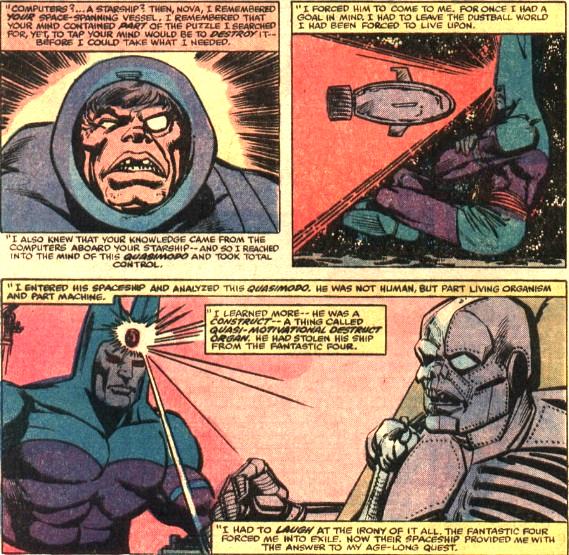
- FF206
Nova 25 was the last issue and continues in the FF. Everything we need
to know can be inferred from FF206, but Nova expands on it. This is the
case with titles like Strange Tales, Marvel Two in One, etc: they are not needed to understand the story, but can be helpful.
Nova's ship and crew: symbolism
Nova's 25 issue story was all about remembering the past and moving on.
It centers on characters who must remember who they really are, and
embrace their past then move on, in order to make the journey to Xandar.
Xandar is the eternal ancient paradise, the place where all our
civilizations' memories are stored, the place of final answers. The
symbolism is clear: to find paradise we must (a) remember, and (b) be
ready to change. These are the true keys to immortality. This is
symbolized by the seven occupants of the ship:
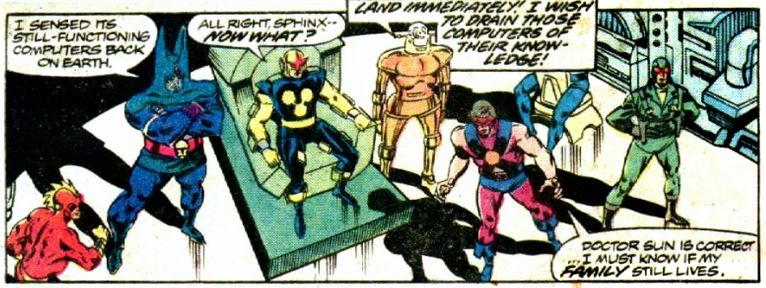
- Nova
The hero on his classic "hero's journey" from being a child to a man. - The Sphinx
The one who has learned the wisdom of moving on: never changing is a curse, not a blessing. - Dr Sun
Dr. Sun continues the theme of the futility of trying to live forever.
He comes from the story of the undead: a vampiric brain in a robot's
body from" Tomb of Dracula" comic. Whereas the Sphinx wants the
knowledge of Xandar in order to end his own life, Dr Sun wants to
prolong his. - Powerhouse
The Xandarian who forgot his heritage. - Diamondhead
Representing our short sighted desires for superficial wealth and power. - The Comet
Nova's mentor from the past, showing how the older generation must make
way for the younger, but they can still be around and be heroes. - Crimebuster
Son of The Comet. When he thought his father was killed he carried on
the family name, showing how the spirit of the family survives death.
|
The new Sue
John Byrne is often credited with making Sue "stronger" - that is,
more violent. Anyone who's read a few pages of this web site (especially
the page on Sue) knows why I come to a
different conclusion. The big difference was that in Byrne's run Sue was
under more stress: she was at the end of her tether. This issue is
where the Sweet Sue of the previous 18 years finally snaps. We then see
her consider her options until FF231 where she sees no choice but to
take desperate measures (see the notes to FF231 for details). But this
issue is her turning point. This is where something inside breaks and
she considers turning to extreme violence, which of course does not work
(see the notes to Byrne's run for how Sue suffers and things get worse
than ever). Sue was always stronger before, when she managed to regain
control. But this is the breaking point. Breaking is called breaking for
a reason: breaking does not make a thing stronger.
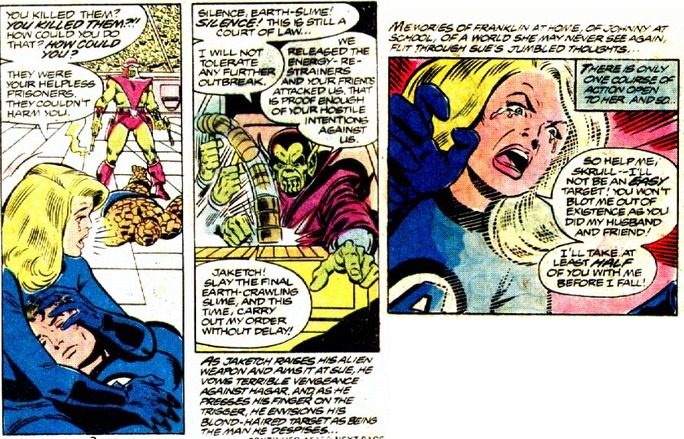
Other points to note
- Reed's trial is guilt for ignoring Franklin
A few months later (Marvel Time) Reed will again stand trial before
skrulls and others (FF262). Both times Reed is technically guilty
(first of attacking Skrulls, and second of enabling genocide). Both
times could have been avoided if Reed had spent more time with
Franklin. This time Franklin could have defeated the skrulls, and
next time Reed would have avoided the despair that drove him to such
a bad decision. Both times Reed is saved by Galactus. ]
- The galactic war
These issues are epic and historic in more than one way. They introduce
the cosmic background to the 28 year epic: the ages old intergalactic
Kree-Skrull war. They lay the foundation for the final end to the war in
annuals 18 and 19. The insights into the political weakness of the
Skrull empire provides the background to the the destruction of the
Skrull throne world in FF244, completing the sub plot began in FF48.
back then the throne world was united enough to hide from Galactus. Now
it is in disarray and easy pickings for the world eater, whose purpose
is to weed out he weak (see FF262).
- The Sphinx is of galactic importance
Though
technically the battle with Galactus in FF213 will be against the
Sphinx, it is likely that the Sphinx helped to organize the
skrull-Xandar war as part of his war of three galaxies. See notes to
FF annual 12.
- Communist symbolism
The Skrulls always represent communism, and their eventual reforms will
represent the end of the cold war. Here we see a metaphor for communist
show trials and behind the scenes leadership struggles that were most
public in the early days of communism.
- The Great American Novel: the symbolism of foreign wars
The splash page, under the banner "death of the FF", says the team have
taken the battle to the Andromeda galaxy. This is the first time the FF
have get involved in somebody else's war, and can perhaps be seen as a
commentary on America. Some see America as like the Xandarians, the
universal police force. Other see involvement in foreign wars as a sign
of betraying the founding father's principles: America, they say, was to
be a place of refuge, an example, as enshrined in the statue of
Liberty: they say that once it gets involved in wars on foreign soil it
betrays its heritage. it is an age old debate.
- The name Nova
When Galactus defeated the Sphinx he called his new herald Nova,
probably to honor the need to move on, and mourn his own inability to do
so.
- The Sphinx came back?
Later another comic tried to make it seem the Sphinx came back, explaining
that Galactus did not understand time travel. That is highly unlikely.
Galactus is a being older than the universe who spends his time
traveling faster than light. There are plenty of time traveling beings
who are far inferior to him. The idea of bringing back the Sphinx from
his endless loop is an irony: the comics cannot move forward, so they
resurrect the character who symbolizes not moving forwards.
- True hyperbole
This issue is called "The Death of the Fantastic Four".
The Fantastic Four is notable for its use of wild hyperbole that almost
always turns out to be true. E.g. "world's greatest comic magazine",
"battle of the century", "collector's item", etc.
207
Issue 207: the prince in waiting

Summary: Johnny's character development
At this stage in the 28 year story, Johnny is waiting to take
over. He should have taken his rightful place when Reed and Sue
left to take care of Franklin in FF72, but Reed failed that test.
Since then Johnny has been an adult treated like a child, and now
it's affecting his self confidence. This issue shows how he is
unable to control his life, and is symbolically (and literally)
controlled by others. He will then gradually rise to his rightful
place: see the timeline in the notes to FF192. Compare this issue with the more confident and mature Johnny in
FF302. FF302 is another group like the enclave: scientists working
in a hollowed out mountain, using mind control. But that time the
Torch wins, without help.
Johnny and Spider-Man
This is the turning point in Johnny's adolescent relationships.
His immaturity with other men is represented by his ongoing
friendship with Spider-Man. Until now he was always showing off.
But now he is finally humbled: he is the dupe and Spider-man
solves the problem.
The zeitgeist
This issue is a commentary on two long term issues that kept
America's attention in the 1970s:
- Middle management.
Johnny's frustration with Reed
is mirrored by the Monocle's frustration with his bosses.
- Schooling:
Those school represents the worst fears
of most American parents: only the super rich can afford good
schooling, and schools just churn out zombies who cannot think
for themselves. Education was a hot topic in 1979 when this
issue was published: in October 1979 President Carter finally
created the Department of Education.upgrading what was
previously a non-cabinet level junior department.
Elitism
As the 1970s draws to a close we conclude the theme of the decade: inequality.
- 1970 began with the team's individual frustrations at Reed assuming he is always right.
- In the bicentennial, 1976, featured stories of equality (see 168, 170, etc.)
- American equality reached its peak in 1978: see the notes to the
climax to the 28 year story, issue 200 about power and democracy.
- Now we see the hopes for equality crumble. The 1980s would see a return to elitism, and it's all prefigured here.
The story features a special school for the elites, and Johnny buys
into it. Right from the start we see the problem with elitism: the
elites can be wrong, just like anybody else. So Johnny, representing
dreams of elitism, must fight Spider-man, who has always represented the
downtrodden man.
The Monocle
The Monocle is a symbol of decline. Ask any knowledgeable fan to name a
mediocre villain and it won't take long before the Monocle's
name comes up. He first appeared at the end of act 3, when Jack Kirby
began holding back his best work and Reed first showed signs of making
mistakes. He now comes back in the issue after the team symbolically
died, as they plunge into their wilderness period. He should be easy to
defeat - his power is represented by the monocle, the symbol of poor
eyesight! Yet Johnny is not suspicious because the foolish idea of
elitism appeals to him. Peter Parker sees through it more quickly.
FF206 continued: sleep walking into the 1980s social decline
The decline is full is symbolism of not seeing what is happening: the
villain has poor eyesight (he needs a Monocle), most of the action takes
place at night, his bosses are hidden in shadow, his servants are
sleepwalking, etc. Note the contrast with the apparent triumph of
democracy in 200, with its bright sunshine and global publicity. Doom
wanted to control people openly but the enclave are doing it secretly
instead: and so they succeed, unnoticed, under the cover of helping the
world's elites.
Real time
In F207 Medusa is captured by the Enclave. Presumably this is the same
event described in Ff240 as "many weeks ago" - strange phrase, not "many
months". Presumably this means less than six months, which agrees with
the conclusion from other issues that the second half of act 4 happens
relatively quickly. The great climax to the 28 year FF story is Ff200,
and the remaining 95 issues of act 4, though almost 8 years in real
time, takes little more than a year in Marvel Time. And what a year!
Other points to note
- Medusa
For the significance of Medusa at the end, see the notes to FF 240.
- The interlude
Why does this subplot appear in the middle of a cosmic epic?
The key is that Medusa is kidnapped at the end. The enclave are
probably working for the Sphinx, and this is part of the wider
cosmic battle in which the Inhumans play a key role. See
commentary to FF annual 12 for details.
- Art
Why does this issue look
so different from the space battles that surround it? As
explained in the letters page to FF211, Marv Wolfman wanted to
to get ahead of schedule by getting another artists to draw an
issue of the FF: that would give Keith Pollard more time on the
next issue. He didn't want to change artists half way through a
story, so made the extra story on a different topic. Unexpectedly
Pollard soon left anyway, but that was not the plan.
- Movies
Note the reference to "Superman - The Movie" at the end. Many
consider that the best superhero movie ever, and it kick-started
the superhero movie crazy that continued with Batman and is
currently benefiting Marvel.
208
Issue 208: the team utterly fails
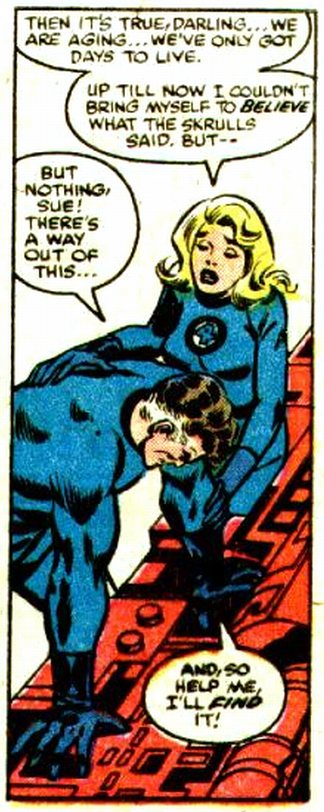
In this issue we see that Reed, Sue and Ben have utterly failed.
Reed swears that he will find the solution, but he fails at that
as well. It is Johnny who works out the solution and provides the
crucial tool in FF214 while Reed lies on his deathbed.
Parallels between the Sphinx and
Galactus:
After FF200 the team tried to make a new start, as if they could
regain past glories. Here they face a being like Galactus:
- His size, coloring and headgear
- How he blasts Nova with his eyes (just as Galactus blasted the
surfer)
- His reference to using the power cosmic
- His reference to brushing the humans away like gnats
- His plan to destroy the Earth.
But this time the Watcher will not help. And this "Galactus" has
no nobility, and can read their thoughts, so the Ultimate
Nullifier won't work even if they could get it.
What should they have done? Ironically the clue is in the end:
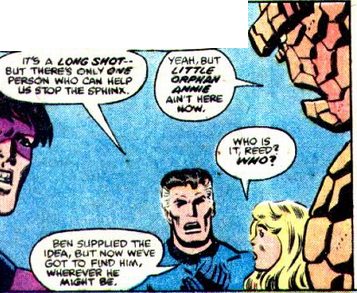
Reed says only one person can help them, Ben jokes about Little
Orphan Annie, and Reed says Ben supplied the idea of who to call.
But there is a little
boy who is treated like an orphan, sent way from his parents at
every opportunity, yet has the power to control galaxies. The boy
is Franklin. They had plenty of warning, Reed should have got to
know Franklin back in FF72, but instead they sideline him, and now
they pay the price. Instead of having Franklin's power they plan
to call on Galactus, exchanging one world destroyer for another.
There can be no permanent solution until they put Franklin first.
Other points to note
- The cover
The cover (one of my favorites, by the way) seems to be a
homage to issue 1. It's not as close as other homages, but I think that
Reed's arm and head position (and the sidewalk angle) clinch it.
The Sphinx is more important than most people realize (see notes
to FF annual 12).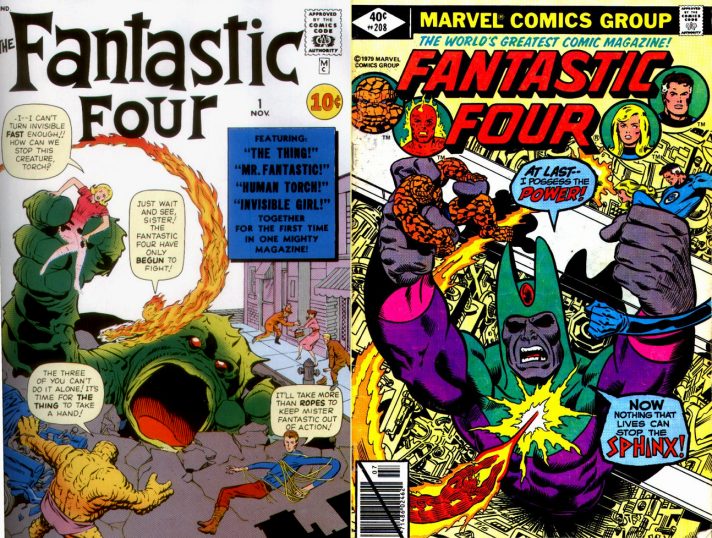
- The cover and continuity
The sphinx is about the need for time to move on, But now he thinks he
can finally move forwards. "Nothing that lives can stop the Sphinx" can
be read as "Nothing can stop continuity." Despite his curse (comparable
to Marvel's resistance to characters aging), some way he will find a way through. Compare the current Franklinverse: it will end eventually. Marvel does change even when it doesn't want to - e.g. the cinematic universe.
- Technology
Johnny notes that the ion ray is transformed into a
transporter beam: the same thing apparently happened before with
the Super Skrull power beam (see the notes about star drives in the page on cosmic topics)
and will again happen in annual 15. Super science follows
rules. It may seem that whatever they need is instantly
invented, but in fact there are surprisingly few basic
discoveries, and their evolution and use can each be traced
through the 28 year story.
- Artistic symbolism
When Johnny meets the team the camera angle makes him tower
over his friends, and in the first frame he shows confidence and
maturity (choosing to ignore Ben's wisecrack). He continues to
be at the top of the frame in the rest of the page, despite not
flying. This emphasizes just how badly the team are doing, and
also foreshadows Johnny's importance in the future when the team
age for real: the future belongs to Johnny, not Reed.
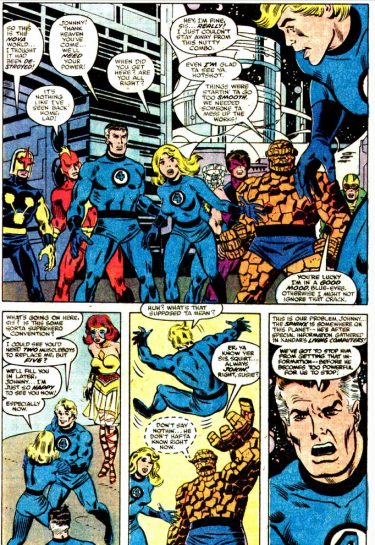
- An educational issue
I love how comics expand the vocabulary. I'm reasonably well
read, but had never seen the word "lambent" before this issue. The
Prime Thoran is describes as like a "lambent" flame, that is,
flickering and dancing lightly.
- Aunt Petunia
When brushed away, Ben refers to Aunt Petunia's girdle. This
is one of many references indicating her appearance and age. See
notes to FF239 for more details.
- Story telling
Johnny is away so that Nova can take the place: their powers and
personality are very similar, so from a story telling point of view it
would be redundant to have them both at once.
209
Issue 209: prisoners of their own past, as the Internet evolves
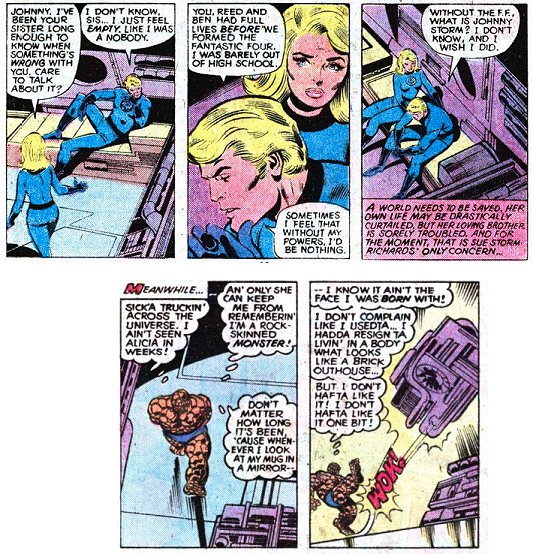
This issue shows us again that Ben and Johnny are not happy. but its
real significance is Herbie. We pause to see the real-world reason
for battling against aging: the comic is under pressure from
merchandising. In this case the merchandise is the children's
cartoon. The cartoon had a comedy robot, so the comic must have one
as well. The reason given in the comic is that Johnny was out of
town when the contracts were signed. This is sort of true: Johnny
was not able to be in town because another company had optioned the
rights to the Torch for a solo project that never happened.
Merchandising requires static characters, and is the driving force
that opposes change. The title of this issue, "The Sargasso Sea of Space" is a
good metaphor for unchanging stories: the same old, decaying
properties linger forever. Marvel is today a kind of Sargasso Sea,
with thousands upon thousands of characters, but only a tiny handful
have the power to interest people.
Realism:
Herbie foreshadowed the real world by many years. The
first affordable general purpose industrial robot appeared
in 2012, made by Rethink
Robotics, and looks like HERBIE, with large eyes that
reflect its inner state (but with a fixed base like Roberta). Its
real world name? "Baxter". As in the Baxter Building.
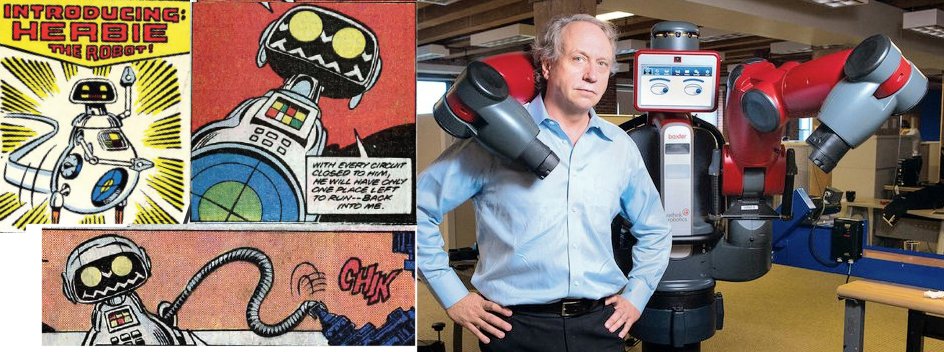
The Internet again
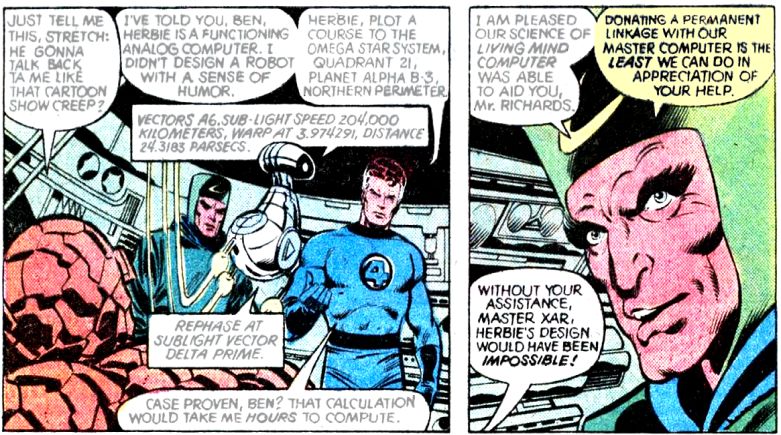
Herbie's importance relies on Xandar technology, especially his
permanent link to the network. He is a thin client, a smart phone. Like
personal computers and phones, Herbie seems like just a toy, but the
significance of the Internet is far, far greater. Dr Sun, with his
origins in vampires (who watch the centuries go by with interest) sees
Herbie's life changing potential more clearly.
It's all about Herbie?
There are many parallels between this Xandar story arc and what was at
the time the longest arc, the Overmind story (see the notes to FF217 for a
comparison). if this story is really about Reed gaining access to
Xandar's computers (i.e. gaining superior information to anyone else)
then Herbie is the whole reason for the journey. Reed does not normally
travel to other galaxies to fight their battles, but access to the living
computers was enough to drive Quasimodo, Dr Sun and even the Sphinx
wild with desire.
Other points to note
- Dazzler: irony
Note the irony of Herbie. The writers at Marvel disliked
Herbie. He only existed for merchandising, and so had no place
in a work of art, and they got great satisfaction from blowing
him up in FF217. A triumph for artistic integrity! Except... at
the end of the same issue, FF217 they introduce The Dazzler, a
character produced by the marketing department to sell
merchandising.
- Zeitgeist following
Dazzler was invented to capitalize on the disco craze, and was
supposed to feature in a live action show, but unfortunately
Disco became suddenly unfashionable. When Marvel tries to
consciously keep up with the zeitgeist the stories fails embarrassingly.
But when Marvel focuses on the best stories possible then the zeitgeist
comes naturally.
- Reed's mind
Note Reed's lack of self awareness. He lectures Johnny at the
end that he should not care what others think. Yet Reed calls
himself Mr Fantastic and insists on taking charge under all
circumstances. Even though he is plainly not the best man for
the job: the whole aging arc has been a series of failures, and
this is not the first time. Reed may be oblivious to others, but
that is not a strength. In the very same frame that Reed tells
Johnny to only answer to himself, he ignores Ben's observation
that Herbie is broken. By ignoring Ben, Reed sets the team up
for yet another disaster when Herbie later goes crazy and tries
to kill them all.
210
Issue 210: the team has lost all direction
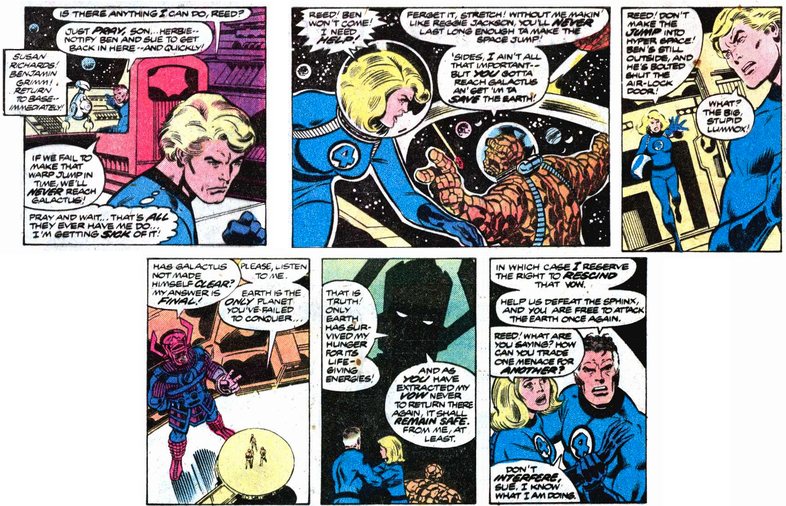
We now hit the bottom of the team's lost period. To recap:
- FF103-196: Reed declines
- FF196-203: a false dawn, everything seems to be back to normal
- FF204-214: no, it's just not working.
- FF204: Johnny is frustrated
- FF205: the team rushes into a battle they cannot win
- FF206: they're growing old and tired
- FF207: Johnny is maturing, and will one day be ready to take
over
- FF208: the team fails because they ignored Franklin
- FF209: they are prisoners of their past, unable to move on
- FF210: they have lost all direction
To see how bad this problem is, consider the bonehead decisions
they make. Some of them are listed in the letters page from FF214
(the writing errors can mostly be interpreted as the team making
poor decisions). Issue 210 was "controversial" which usually means
that most letters received by Marvel were negative. The editors
made no attempt to defend the story.
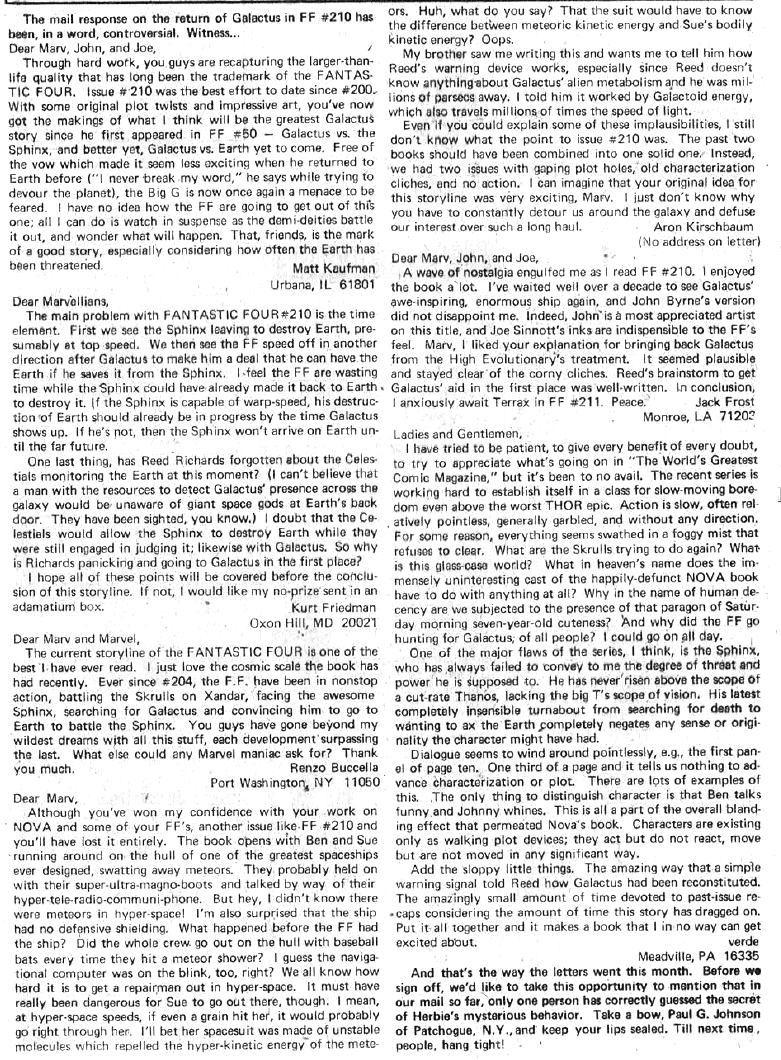
The few positive letters were short, and simply praise the attempt
to copy the past. But the more thoughtful letters point out that
copying the past is boring! We need character development!
If we search the Internet for reviews we find almost none. Most
readers liked the art, but nobody could make sense of the story: why
do the characters lack purpose? Why do they waste so much time, make
poor decisions, and do dumb things? It's as if they have lost all
hope and direction and are just going through the motions: which is
exactly what is happening.
This is the period fans refer to when they say the FF story began to
lose its way before Byrne. (They also refer to Moench's run, from
FF219 to FF231, but that run features massive character development,
and is hugely misunderstood in my opinion.)
Ironically, this lack of character development in FF210 is itself a
character development. The Fantastic Four has always changed and
moved forward. This lack of change is itself a change. The team is
lost. Soon (under writer Doug Moench) they will give way to
desperation then despair, and then (under writer John Byrne) to
denial and finally self destruction. There are major changes
underway, but we have to stand back to see the big picture.
Suicidal tendencies
The only one to really appreciate the emptiness of this period is
Ben, because he started down this road to depression long ago. At
the start of this issue he is eager to die on the surface of the
space ship. Compare FF297, where he goes even further, again on the
surface of a ship: both are reminiscent of the original space
journey where his life fell apart. Ben's famous inability to give up
is not just courage, it's because he doesn't value his own life very
highly.
Giving up on the Earth
Talking of suicide, this is one of the greatest blunders of Reed's
career. In the letters pages (in FF214 and FF215), several fans
observed that the Sphinx would arrive at Earth before Reed had time
to do anything. This is especially true when we add in the time
wasted in FF211. Reed must have known this, yet he chose to leave
the Earth to its fate! He could have contacted Black Bolt, who
defeated the Sphinx in FF annual 12. Granted, the Sphinx is more
powerful now, but Black Bolt is no fool and could have spoken to
him, or found a way to delay him: the Sphinx is 5,000 years old and
in no hurry, why not ask him to tell his life story again? Reed
could have split the team in two, one half to delay the Sphinx and
one half to see Galactus. But instead he left the Earth to its fate,
and only luck allowed the Earth to survive. Arguably the biggest
threat to the Earth is now Reed's stubbornness. Reed should be a
scientific adviser, not the leader.
"You're thinking too hard, these
stories are fun!"
Always remember that this web site focuses on the bigger picture. I
don't spend much time talking about the surface adventures. Yes,
these stories are fun! They are bright and exciting! Reed Richards
is a hero! That should be obvious. These stories work on many
levels. On this web site I mainly talk about the deepest, darkest
level, because that's a big, subtle, rich story that is so often
missed.
The 1979 zeitgeist
This is the great American novel, and this issue was dated September
1979, on sale in June, and would have been written around March or
April. The lack of direction and general weakness was the zeitgeist
of the 1979. This is from presidential
timeline.org:
- March 28, 1979 The worst nuclear accident in the U.S. occurs
at Three Mile Island, Pennsylvania, and causes serious
apprehension of American pursuit of atomic energy.
- July 15, 1979 Carter delivers his “malaise” speech on national
television, calling Americans out on their “crisis of
confidence.” Though initially received positively, the public
eventually attributes problems to Carter’s lack of leadership.
- July 17, 1979 Carter asks his cabinet to resign in an attempt
to restructure his administration among growing criticism.
Thirty-four officials submit resignations.
Please note: like many Europeans I am a big fan of Jimmy Carter: to
me, the long term good he did (improved relations with China, less
reliance on oil, limiting nuclear weapons, etc.) outweigh his
domestic problems. But obviously to Americans the domestic problems
were more pressing, and they soon got rid of Carter, seeing him as a
lame duck.
Criticisms (source)
- The kiss of life:
How does Ben give mouth to mouth resuscitation to Johnny? As we
see in various issues, Ben's face is flexible between the rock
(hence he can have different expressions). He can also blow
harder than most people. Mouth to mouth does not require a seal
between the lips, it simply requires air to be forced down the
throat, and Ben is good at that. In fact, this was barely even
needed. The human body can survive in a vacuum for a minute or
so, so any damage was mainly shock.
- Ben's dialog:
"The Thing has always had
corny battle cries, but it seems he calls himself the
'ever-loving Thing' on every page of this book [the 204-214
arc], which quickly starts to grate on the nerves." In
FF210 Ben explains why: he's trying to be cheerful, to prevent
the team from giving up.
- The Celestials:
Why is Reed is bothering with Galactus and the Sphinx, when
according to the Eternals comic, the Celestials are standing in
judgment over the Earth, and surely would not let the Sphinx
destroy it first. The Eternals comic, the most notable creation
of Jack Kirby after his brief return to Marvel, was not
originally intended to be part of the Marvel Universe. This
illustrates how the best comics need freedom. Yes, if they
connect together then we get an even bigger story, but the story
is big enough to allow different points of view. From the point
of view of the Fantastic Four comic, Marvel gets its information
from interviews with the FF, and all other comics are largely
guesswork. Readers of other comics are free to have their own
theories.
- Batting meteors:
Why does the ship at the start not have its own protective force
field? Does the regular crew swat away every meteor that
arrives? Clearly the ship is already damaged.
- Detecting Galactus:
How does Reed detect Galactus' presence when he could be
anywhere in the universe? Reed uses alien technology. Then why
don't other planets detect him and avoid him? As the only
scientist to ever get close to Galactus and survive, Reed had a
much better idea of what to look for. it is likely that Reed is
unconsciously guided to this technology by Franklin, as unknown
to Reed, Galactus is Franklin's herald (see FF600 and notes by
FF74).
Other points to note
- Their ability to use their powers fluctuates. In one issue
they say they feel weak, and in the next they can do a little
more. This suggests a large element of despair and fatalism, not
just physical decline.
- Throughout this arc Johnny is increasingly frustrated with his
junior status. FF214 will be a major turning point.
- Aboard Galactus' ship Reed once again indicates that he wants
to study every alien ship he finds. See *superhero technology*.
- We learn that Sue's family dies young. This is another reason
she likes good hair and beauty so much: her family loses it so
quickly. It also explains why Sue doesn't say as much as the
others: she has a more serious outlook on life. She had no
childhood (she had to raise her brother) and she will die before
she retires. She has it tough.
- Note the use of the Kirby Triptych (three similar images at
the end of the story) for extra drama. See the notes to FF3 for
other examples.
211
Issue 211: Reed is weak and everyone humors him
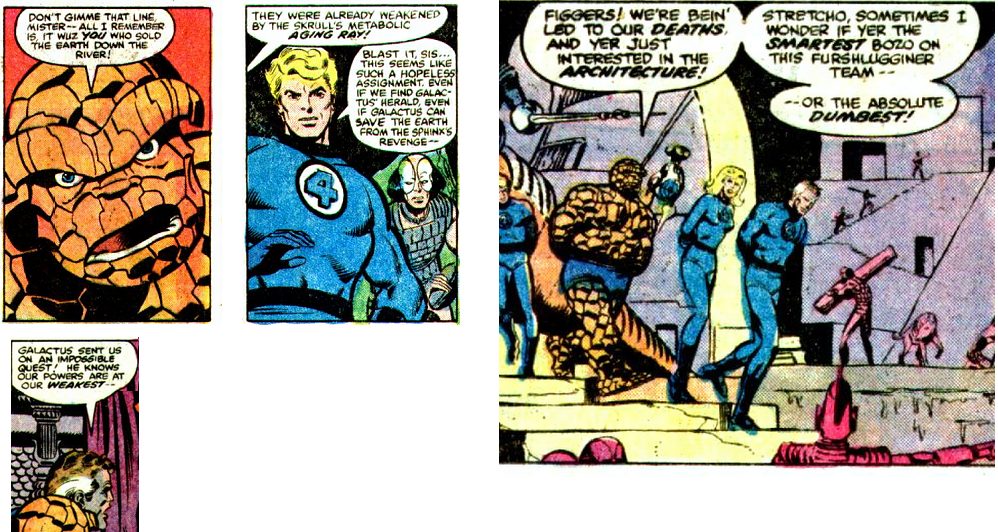
This issue is Reed at his weakest. He thinks his genius secret
plan will save the world, but everyone else can see he is like a
child. Ben can see that Reed's plan is stupid, and that Reed is
easily distracted from what matters. Johnny can see that Reed's
plan is extremely unlikely to work. Even Reed himself despairs.
Galactus is toying with them too. He gives them an easy task:
they simply need to hit Tyros once. We saw in FF210 that Galactus
quite likes the FF. In FF211 we again see the extent of his
Galactus' power. Next issue's "defeat" of Galactus must be seen in
that context.
Other points to note
Galactus compares his heralds to earth, air, fire and water, just as
FF are also compared. He will have one final herald, Frankie Rae
(the new Nova). Like Firelord, she represents fire. Firelord did not
feature on the FF, and other comics are less reliable (given that
only the FF report directly to Marvel), so from the point of view of
the FF comic, Fire Lord can be considered a minor character and
simply a precursor to Frankie.
212
213
Issues 212-213: the future of mankind: the greatest cosmic battle of all
I don't usually combine issues in one review: I figure that any
comic that does not give a complete story is wasting my money. But
in exceptional cases I make an exception. The build up in FF212
was so superb, so exciting, so page turning. and the pay-off in
FF213 was so magnificent, that I don't mind that FF212 was just a
build up and noting more. This two parter is worth the money.
At the end of FF211 the Watcher announces this to be the
greatest cosmic battle of all. This is the climax of the story
that began in FF annual 12, announced as a major event, and so it
is: not just the greatest battle, but the climax of the longest
arc in the entire 28 year story (FF204-214, plus annual 12). The
significance to Reed is also huge: he becomes almost irrelevant.
He thinks he is in control but he is not.
The Internet and world history
Quasimodo = machines set free
Quasimodo represents machines set free. He arose in FF annual 4, the
issue about the massive power of intellectual property: both stories
were about the power of information as a separate entity. That was the
mid 1960s when computers began to be used routinely by big companies.
Then in FF202, Quasimodo discovers a whole network: a massive hub of
data is able to broadcast across the galaxies. He became VERY excited.
Note the symbolism in that issue: the home was no longer tied down, and
ended up in a jungle. Ben preferred that location: the Internet can free
us to live where we want, but also appeals to people who love a new
untamed world. But in FF202 the machines attacked people, just as Herbie
did later, so the jungle location could be a bad symbol: of being cut
off from our fellow man, where machine stake over, and mankind is
perhaps returning to a pre- industrial society.
The whole Andromeda storyline takes place off earth, in what is
effectively cyberspace (the family is beamed up to a world of
computers). It is a world of great danger, where savage Skrulls try to
destroy the wisdom of the ages. This whole cyberspace zeitgeist was
reflected in the movie Tron, conceived in 1976 and released in 1982.
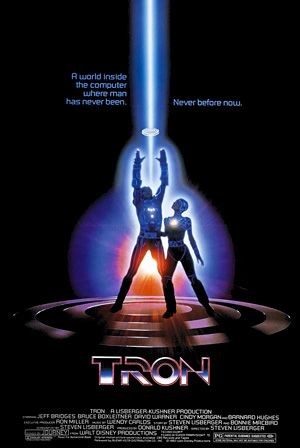
The Sphinx = human history
Wile Quasimodo and Xandar represents cyberspace, the Sphinx represents
human history: he has been around for most of it. He also represents (at
first) the cycle of life: as in the riddle of the sphinx, he recognized
the need for each life to change and come to an end. But now he has far
more knowledge and thinks he can do anything, and does not care if he
destroys the world in the process. This is like modern man since the
industrial revolution: we forget our ancient limitations and think we
can do anything. In doing so we cause mass extinction and poison the
planet. Will we learn cosmic balance? Can we enjoy technology without
being intoxicated with power like the Sphinx?
Galactus = force of nature
Galactus is a force of nature (see FF262). He is as old as the universe
and cannot change: he represents the unchanging reality that no matter
how powerful we become, there is always something more powerful. So the
battle between the Sphinx and Galactus is the battle between human
arrogance and universal limits. Note that If the sphinx had cared for
others he could have continued his growth. But because he does not care
the force of karma will defeat him.
A political-economic approach
We can also see the Sphinx as the Democratic party and Galactus as the
Republicans at the time: the Democrats stood for what they saw as
progress, and the Republicans stood for what they saw as economic
realities that did not change and could be harsh if not respected. Or we
could see the opposite symbolism: the Sphinx's links to Moses remind us
of Jimmy Carter, a prominent member of his local Baptist church,
whereas Galactus feeding off planets reminds us of the power of the
market place.
Galactus, the force of nature, reminds the uncultured Terrax (who
symbolizes Terra, the earth) that mortals must serve nature and not
think they can be its master.
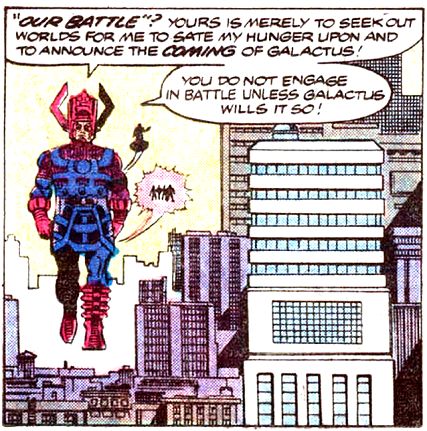
The timing of the battle: 1978-79
Mankind had reached this point with the information revolution that
began with the first network. We now have the potential for vastly
expanded information, and so vastly accelerated change, either for good
or evil.
This also coincided with glottalization and a turning point in equality:
after the upheavals of the generations following WWI, which upset the
ancient class system, in 1978 the rich again began to take a larger
share of the world's wealth (see the notes to FF200 for details), just
as the Sphinx wishes to return to the absolute monarchy of ancient
Egypt.
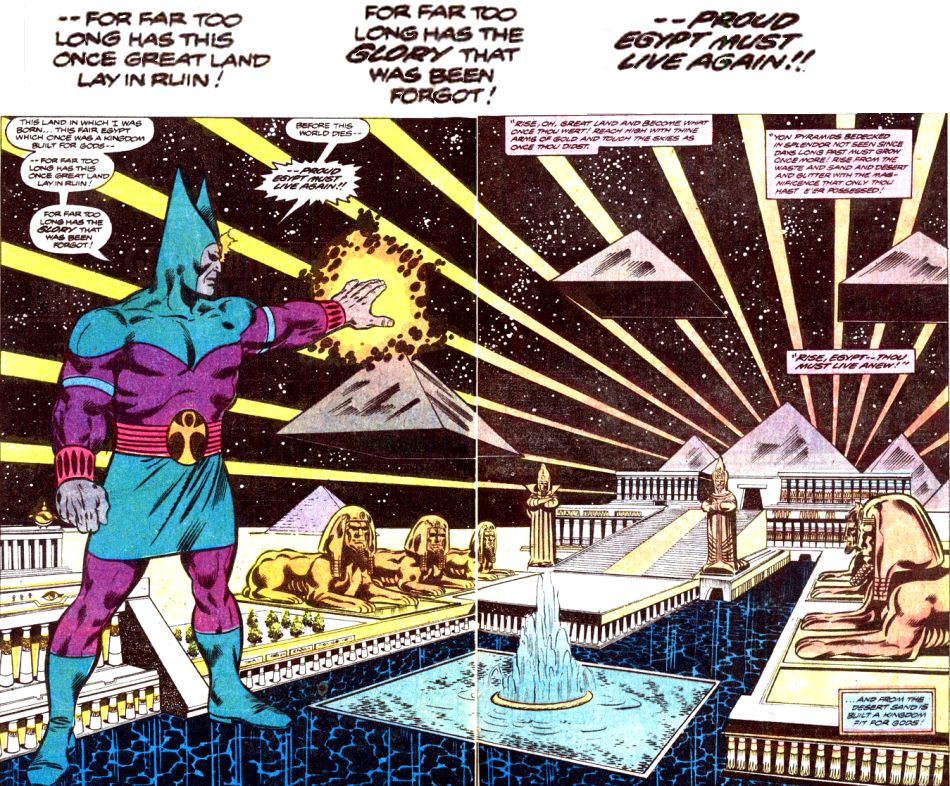
These are events of cosmic significance: will mankind move forwards to
the next stage, or destroy itself with its hubris, or stay in the past?
All of this is symbolized in the battle between the new opportunities
seen by the Sphinx and the eternal realities represented by Galactus.
So that is why the Watcher was so interested in Xandar and the period
1978-1979, and why the battle between the Sphinx and Galactus was so
symbolic.
|
Why does Galactus fall for the
fake nullifier?
In FF210 we saw that Galactus likes Reed. He is not hungry, he is
happy to be deceived, and is in no hurry to come back. Is Reed
really smarter than Galactus? Is Galactus unable to see inside a
toy? Even comic readers can see that a fake nullifier was a silly
idea. Yes, the Watcher's mind probing
helped, but it could only stop Galactus because he wanted to be
stopped. Recall Galactus' statement to the Sphinx: he, Galactus, is all
powerful, and yet he is not a God: he is not in control of his destiny.
he comes to Earth to eat it because he must, but that does not mean he
wants to.
The bottom line is that
Galactus is Franklin's herald. The world is safe because Franklin
wants it this way. But Reed of course does not know this, and the
Watcher isn't telling.
For more about why Galactus appears, see the discussion by FF74.
Reed's lesson
Reed is almost insignificant compared to the powers around him. He
only has any influence at all because years ago he earned the
respect of more powerful beings. Will he learn the lesson? Will he
turn his great intellect to the challenge of becoming friends with
more powerful beings? Will he be humble and make Franklin his top
priority? Not yet. Reed has been humbled but he does not yet know
it. He always had little self awareness. He must suffer more yet.
Reed lost
The greatest cosmic battles are not about energy, they are about
ideas. This battle is the great cosmic battle of Reed Richards
against Galactus. Reed has lost: he is just a mortal and as such
will die, but instead of investing in his family (the only way to
ensure immortality) his skill will die with him. As for his mighty
brain, it was unable to stop the aging ray. He has even lost
against Galactus, who is only humoring him, but Reed's ego will
not let him see it. When Reed finally admits his weaknesses in
FF295 he will see things as they are, and will have won, and
finally be able to move forward and get what he wants.
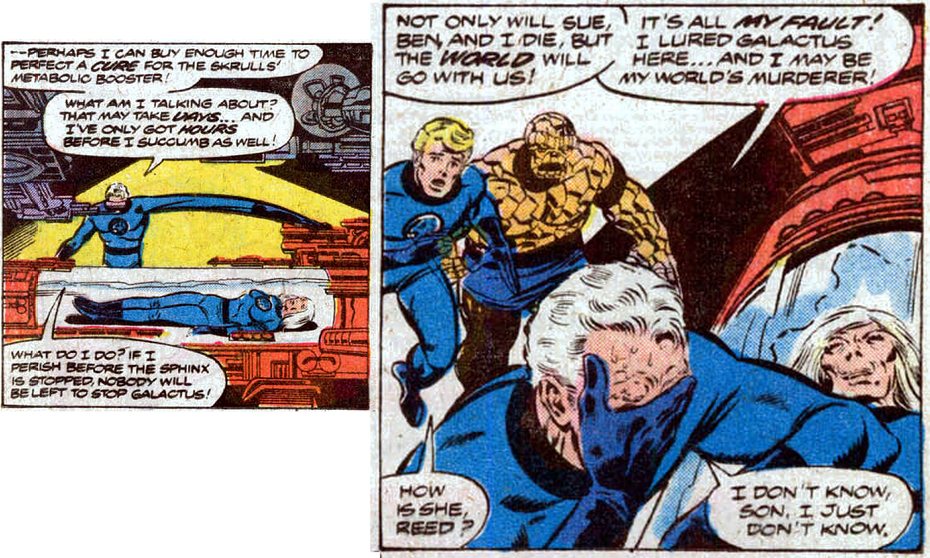
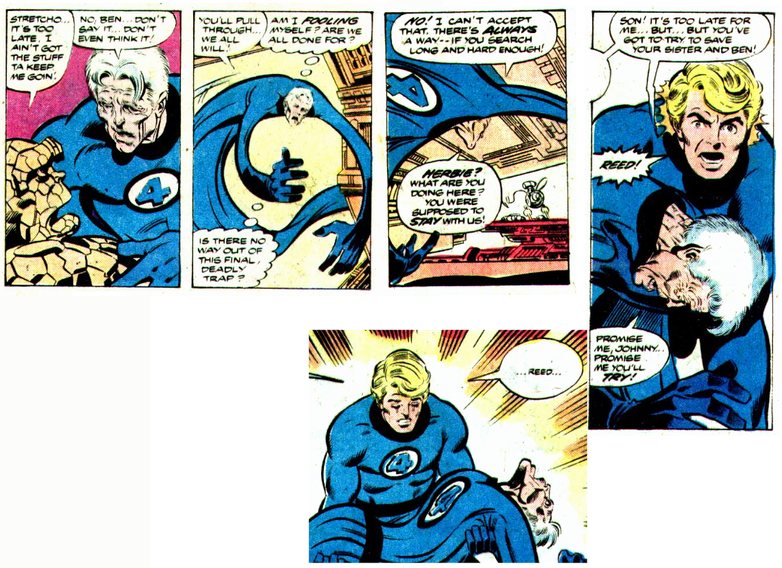
This whole arc is about time: time comes to us all. The Sphinx lived
5,000 years, wanted to die, and cannot. Now he must live the same
events endlessly, like a comic character who can never grow up.
Meanwhile Reed and Sue and Ben learn that they cannot cheat time.
Galactus and the end of the world
Galactus promises that when he returns, the world will die
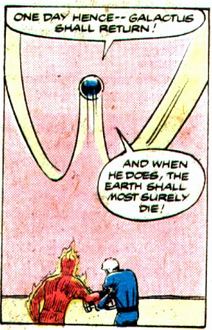
Galactus' word is truth (see FF 50). Galactus did return, and the world did die, along with the entire universe, in The Great Reboot. This is how it happened:
In FF 240 the Inhumans left
Earth. Rather like the dolphins leaving Earth in the Hitch-hiker's Guide
series this should have been a warning: the last time they planned to
leave Earth was when Galactus came to destroy it (see the notes to FF48,
and how Maximus called Galactus).
In FF241 they arrive on the
moon, and settle on the exact spot where the Watcher kept his most
advanced technology. The official story was that they were simply
escaping Earth's air pollution, and landing in the Blue Area was just
coincidence. But this is a highly advanced race with a great many
secrets. If it was just air pollution they could have fixed it.
Something far bigger was going on.
In FF242 Galactus arrived,
hungry because the influence of humans had made him question his
existence. He was chasing Terrax, the herald he created in this arc.
In FF243 his weakness and
self doubt caused him to almost die. But FF 262 reveals that when
Galactus dies the universe can no longer reach its destiny: it
effectively grinds to a halt. It is the end of not just the Earth, as
Galactus said, but the universe.
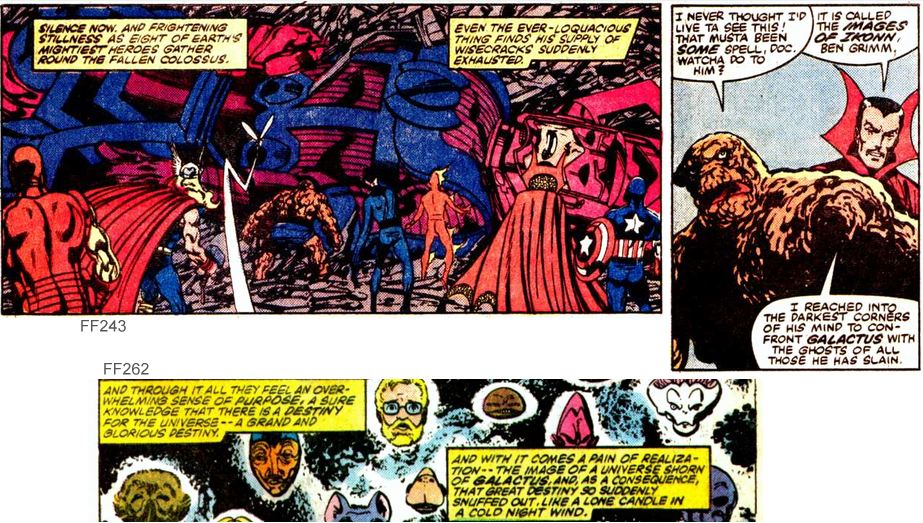
In FF244 Galactus is saved.
He says that Earth no longer needs fear him, as Earth is now his friend.
This is taken as a good thing, but is it? The role of Galactus is to
destroy. By saving the world destroyer it appears that Earth has become
his friend: like him.
Saving Galactus is a very bad idea, as discussed in FF 262. Reed was set
free not because he was innocent, but because it suited Eternity. When
it suits Eternity to support genocide you know that something very bad
is on its way.
FF245 is about Franklin being unable to grow up. Franklin controls the Marvel universe. If Franklin cannot grow up then neither can the universe. This is a Very. Bad. Sign.
The next time we see Galactus (FF256-7) the story is about how he is still
dying, because his inner doubts are the same. He destroys
the Skrull throne world, but that does not change anything: he is still
the changed Galactus because Reed is
still his friend, as he makes clear in FF262. Galactus is not
supposed to have friends! We are not supposed to befriend genocide!
Galactus is a force of nature and no longer a man. He cannot and should
not function as a human, he is supposed to be the final test,
not a person's friend. Friends do favors, like killing Reed's
enemies, the Skrulls! This is all wrong!
So next time we see Galactus after that, in FF338-341,
his inner conflict is complete: he has grown mad, and is eating the
entire universe. This is the end of the world, the end of the universe,
the Great reboot, and the process began in FF 242, just as Galactus
foretold.
For more details of how saving Galactus led to the end of everything, see FF340. it explains how in FF244 the weakened Galactus was infected by the dreams of the Black Celestial.
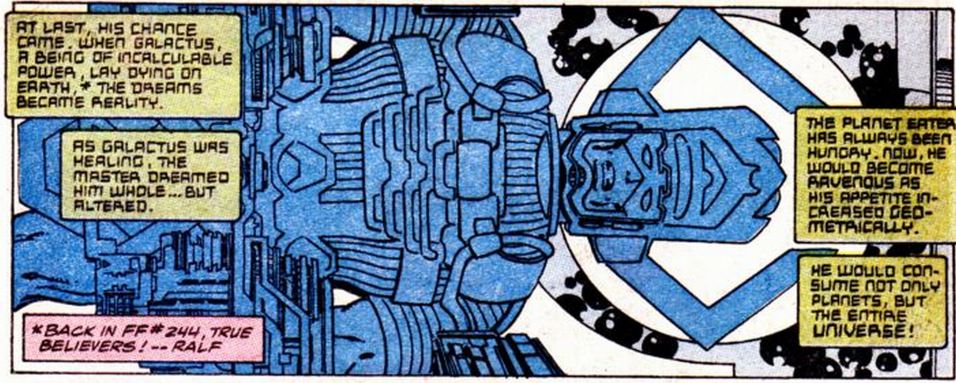
A weakened Galactus is far worse than a strong Galactus or no Galactus.
Had Reed let him die he would have come back at full force
(he is after all a force of nature). But allowing him to continue in a
weakened state allowed others to control him, and the result was the end
of everything.
214
Issue 214: we see into Johnny's soul
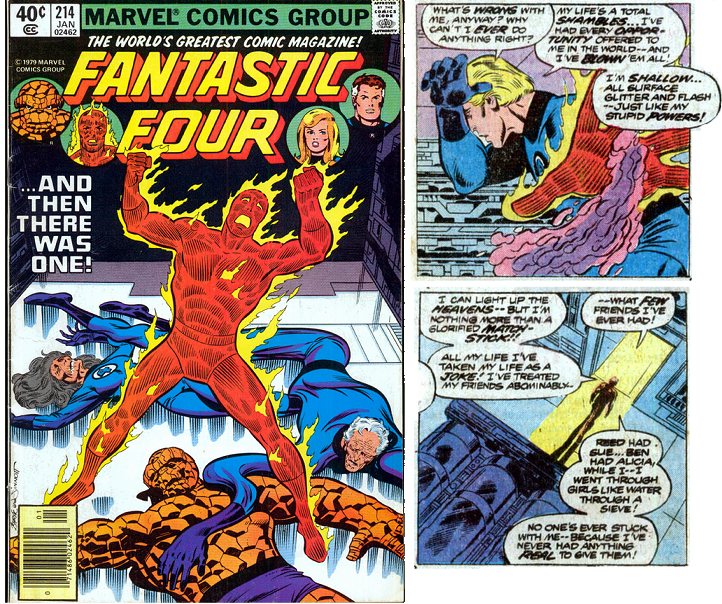
This is Johnny's finest hour. He saves his family. Yet all the
time he feels powerless and scared, and in the end he feels
powerless. He's always lived in the shadow of Reed or Sue. He
thought he was growing up to be a man when Crystal left, but his
failure with girls and the break up of the team left him without
any emotional foundation. Although he is now 26 years old, he's
emotionally like a teenager: full of hope and confidence, but deep
down insecure.
Johnny still has some way to go
In this issue Johnny proves what he can do, but also proves that
this deep insecurity is still there. This insecurity will gnaw at
him over the next year as Reed an Sue continue their decline.
Johnny will not find inner security until FF213 (he knows that he
is a hero), and especially FF300-307 (Alicia provides him the
emotional stability he needs, and his big sister no longer looks
over his shoulder.) Only then will he be emotionally and mentally
a healthy, confident, independent adult.
Other points to note
- Irony
In FF213, the Sphinx is condemned to forever repeat the past. In this,
the next issue, the FF are condemned to the same fate; by returning to
the status quo we are shown that they will have the same kinds of
stories and fight the same kinds of people forever, and can never escape.
- Missed opportunity
Here we finally see into Johnny's soul.In the real world this would have been a powerful beginning to the next generation. This does not mean Sue and Reed could not be cured, but it was the perfect "moving on" point. but the opportunity was missed.
- How old are they?
Reed, Ben and Sue say they feel younger and stronger at the
end. Reed appears to have
de-aged by seven years, taking him from age 46 to age 39.
This de-aging makes his haggard look in FF232 all the more
significant: the events of the next year will have a terrible
effect on his health. Meanwhile, Byrne's original script for FF232
indicates that Sue was then 29 instead of the expected 32,
indicating that the ray took just three years off her. She was
already young and close to her prime.
- De-aging was the long term plan
"“The age problem with the FF was
apparent in the ’70s, so yes, the idea was to de-age them. I knew this
ending before I started the aging storyline so we could make them young
and didn’t have to deny previous stories.” (- Marv Wolfman in "Back Issue" 74)
- Who wrote this?
"Byrne later stated that
he did most of the plotting on #214 and Wolfman rewrote some
scenes without his knowledge." (source:
"Joe")
215
Issue 215: another warning to Reed
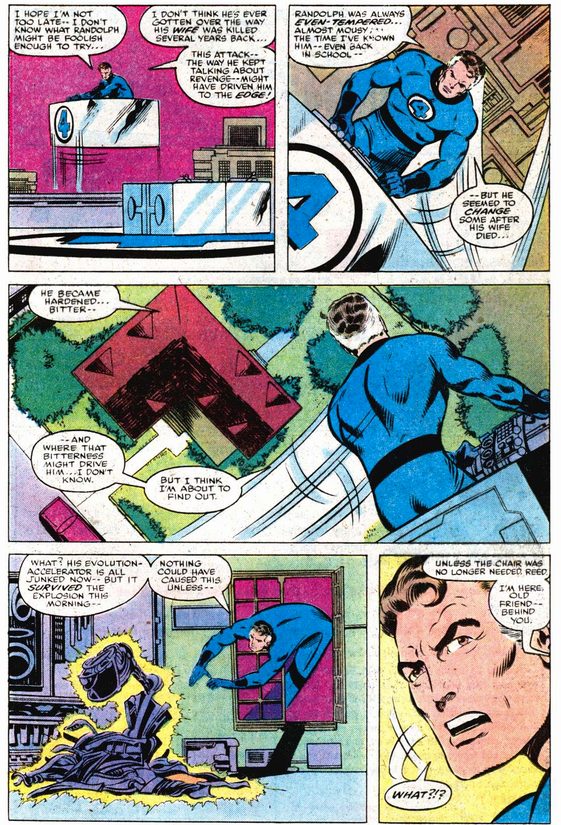
In FF204-214 we saw how Reed had failed. In FF215 we see a
warning of what will happen next. Randolph is an obvious parallel
for Reed:
- They were scientist friends,
- They study the same kinds of things,
- Randolph calls Reed "old friend" (Reed's favorite term for
Ben, it's a term not used by anybody else, or at least not
often).
- Randolph is under stress since his wife died, just as Reed is
under stress since Sue left him. Although she came back she is
now more independent: the golden era where she treated him as
superior are long gone.
- Like Reed, Randolph is making dangerous mistakes.
- Like Reed, Randolph thinks he can do everything himself.
- Randolph goes too far and then destroys his equipment,
foreshadowing what Reed will do to the Baxter Building in FF279.
- Randolph sees him above others, as Reed does. Randolph will
not listen to others, just as Reed will not listen to Sue or his
child if he can avoid it.
- Randolph is like a god, just as Reed thought eh could act like
a god, single handedly solving a galactic war and then facing
down Galactus.
The Great American Novel
This is like the warning in FF108 (where Janus is like Reed), but
this time we see that the Reed stand-in has become more distant, and the only solution is to leave.
In each case we have a treat: a slice of America we rarely see
in comics: a hoely street scene. This emphasises the contrast
between Reed and the Reed-parallels, cut off from humanity, and the
human world the are losing.
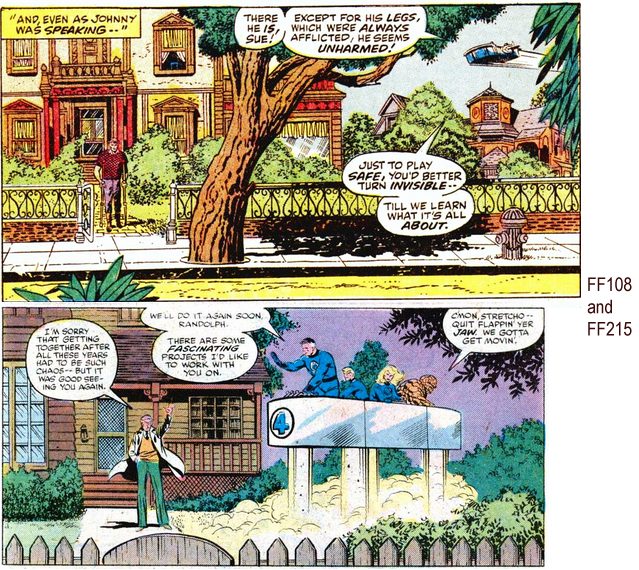
This is also a sign that John Byrne's art is consciously modeled on
Jack Kirby's. But notice all the additional interesting details in Kirby's version: he is called the king for good reason.
216
Issue 216: Franklin is the answer, stupid!
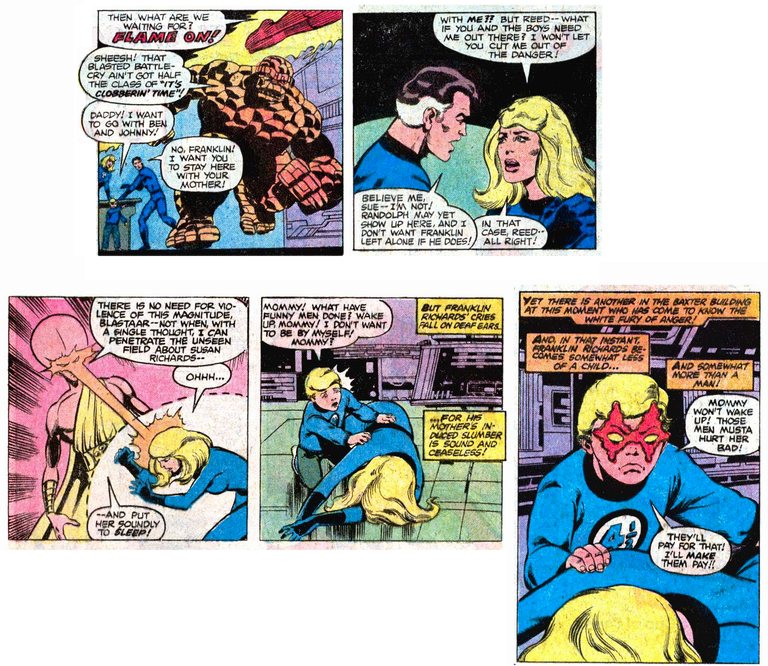
Over the past few issues I've been very harsh about Reed. But
what was he supposed to do, faced with the Sphinx and all those other
dangers? The answer was under his nose since 1968. It;'s Franklin! Franklin can solve the problems, if you only let him!
In this issue we are reminded again of Franklin's awesome power, but still
Reed ignores him and sidelines him. From now on until the start of Byrne's run, it's all about
Franklin.
- FF203 told is what Franklin can do.
- FF204-214 shows us how the team fails without Franklin.
- FF215 is a warning of worse to come as Reed ignores his son
- Annual 14-FF231 focuses on Franklin.
- FF232-295: John Byrne famously disliked using Franklin, and
even asked if Franklin could be killed off (the editors said
no). In doing so Byrne was just reflecting Reed's views. But
Byrne's run shows the greatest changes of all: the climax to the
Franklin saga. Despite the writer's intentions, the force of
this epic writes itself.
From now on, Reed no longer
has any excuse. And the next issue, annual 14, drives home the point.
Other points to note
- The splash page
The splash page shows Times Square and various billboards. Two
billboards are for then-current Marvel comics: Epic Magazine and ROM.
The one on the right is supposed to say "Coke its the Real Thing". But
Byrne - without saying anything, changed it to 'Cuba' instead of Coke.
This reflects Byrne's views (see the discussion of Reaganism by FF247).
The change is not obvious in the printed comic, due to the position of a
large word balloon. But it became obvious years later in the second
printing of "The Art of John Byrne". Thanks to Karl Disley for pointing
that one out!
- Byrne's cameos
The splash page also has a cameo of John Byrne in the lower right
corner. In later issues look out for him on the cover to 327, as a cab
driver when he starts
writing, and of
course his main role in FF262 and in The Thing issue 7, in "assistant
editors month"; he is probably the bearded redhead who admires She-Hulk
in FF321, given the reference in 328. Finally, it looks like his head
as a trophy on the wall in DeFalco's run. :)
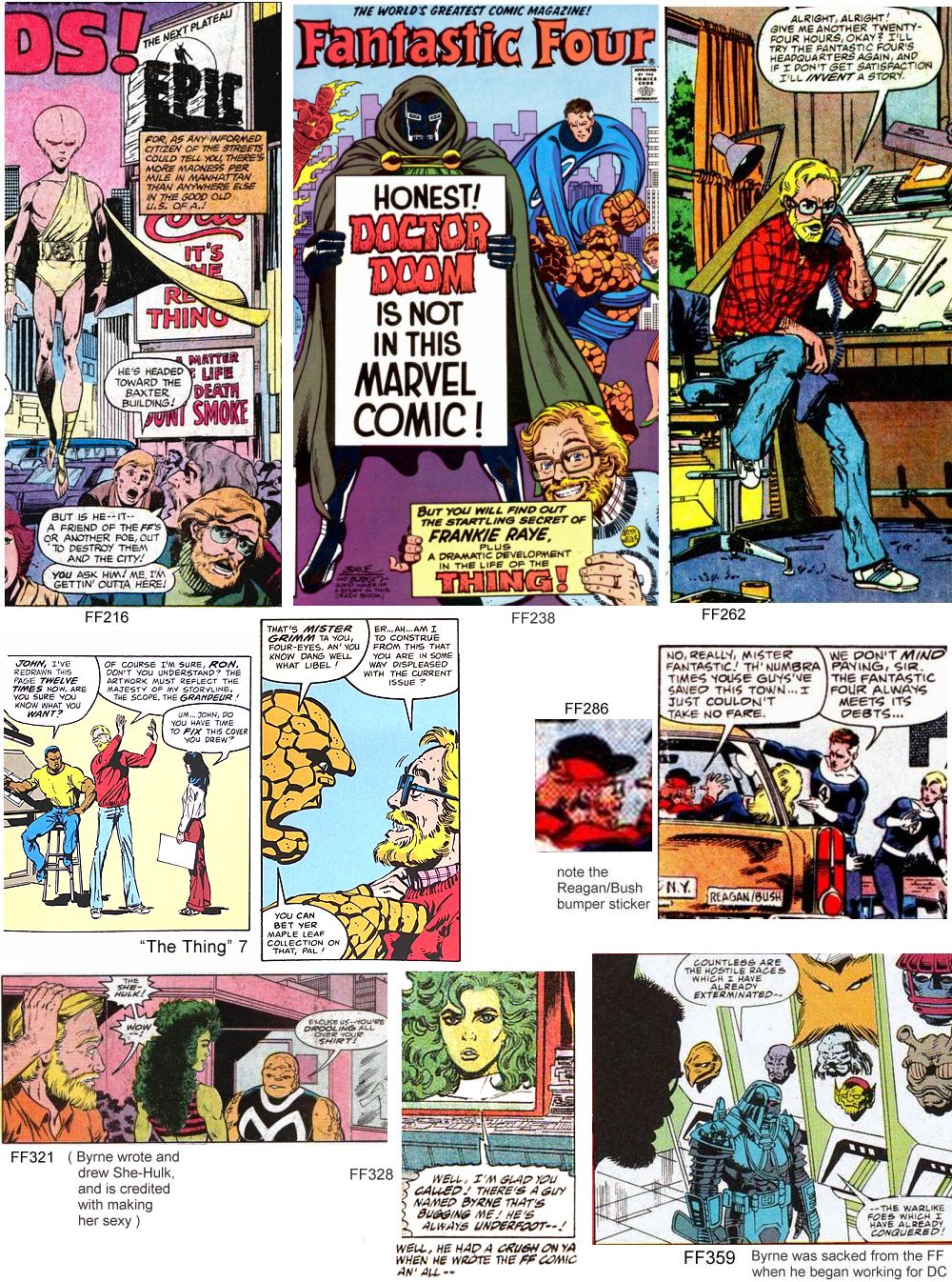
A14
Annual 14: Reed loses all credibility
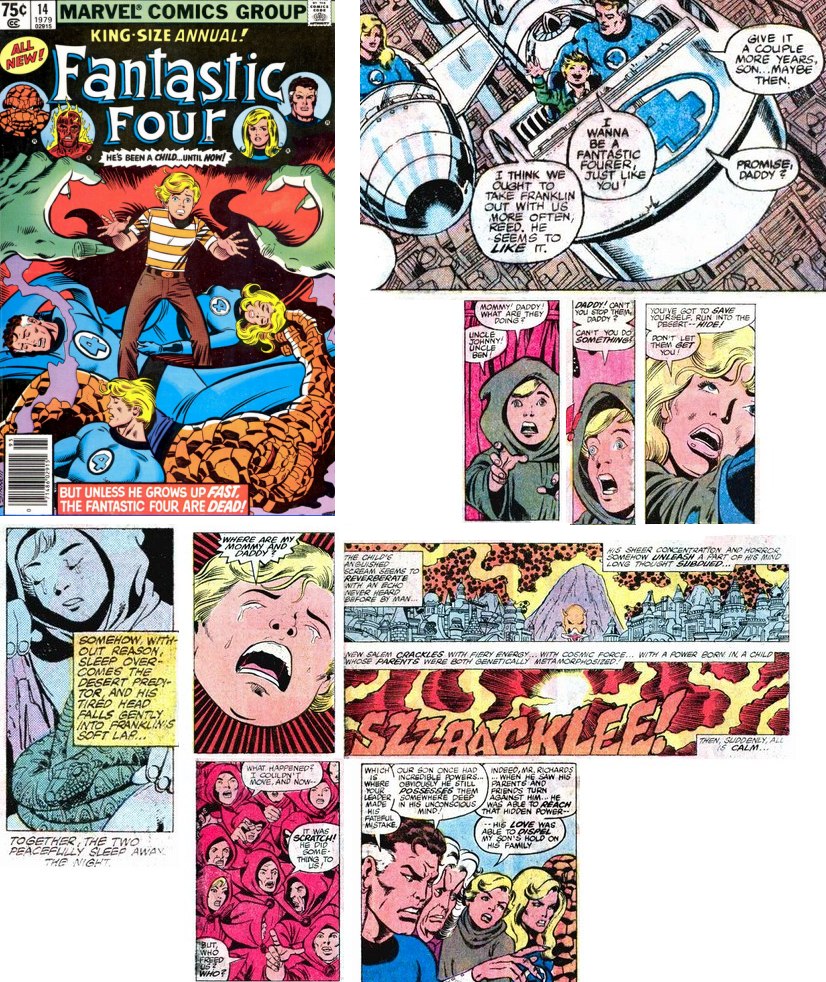
As if FF216 was not clear enough, FF annual 14 immediately
follows, and drives home the point: Two issue back to back
featuring his power and Reed's utter neglect. This may seem like
overkill, but the point must never be forgotten: Reed's neglect of
Franklin is the heart of the 28 year family story.
What was Reed thinking?
This issue has been often criticized as too similar to FF186, but
that's the point! Reed is blind where his son is concerned. They
need to go on holiday, so he decides to go to New Salem! New Salem!!! What
was he thinking??? Just a few months ago (their
time) Franklin was kidnapped there and they were all nearly
killed! As Karen
of Bronze Age Babies puts it, "Seriously, the FF decides to take a break and they go
to a town of witches? Another reason I refuse to believe that
Reed Richards is the smartest man on the planet."
True, Nicholas Scratch has been banished and/or killed, but these
are ancient witches! His followers! Does anyone think a little
thing like being banished/dead would stop the spirit of a powerful
warlock? On the way there they acknowledge that there could be
ghosts. That mean Scratch could still be a threat! Reed's
appalling parenting amounts to criminal neglect. And sure enough,
Franklin is traumatized, and again his power saves the day
(twice).
A conspiracy theory
A conspiracy theorist might draw a connection with the Over mind
debacle, where Reed's friend Agatha used her son to try to make
Reed look good (apparently: it's speculation, but that is where
the evidence points). Is that the reason why Reed, after so many
disasters, wants to go to Nicholas Scratch's old stomping ground,
to impress his family with an easy win? he presumably knows that
Agatha can always defeat her son, so maybe he thinks this is safe?
That's just a guess. But I think it's more likely that Reed is
just being incredibly stupid.
Sue
I suggested in the Andromeda story that perhaps Sue is Cassiopeia:
perhaps she is the one to blame. Reed, it could be argued, may
have autism so cannot help missing the big picture while he
focuses so much on the details. Meanwhile, we know that he will
always obey Sue when pushed (he at least learned that lesson from
the separation). So it could be argued that Sue is the one at
fault: she genuinely loves Franklin, she could fix everything by
pushing Reed in the right direction, but she doesn't. She is so
keen to have a harmonious family (after her own lonely childhood)
that she won't create waves. Ironically by being so supportive of
Reed she creates the very disharmony that she fears.
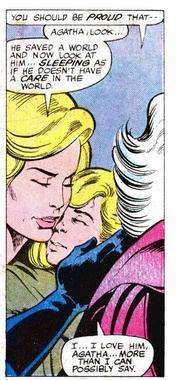
Children are the answer. That is the four word summary of the
entire 28 year story, and foreshadowing the happy ending in Act 5
217
Issue 217: Reed's barrier goes up
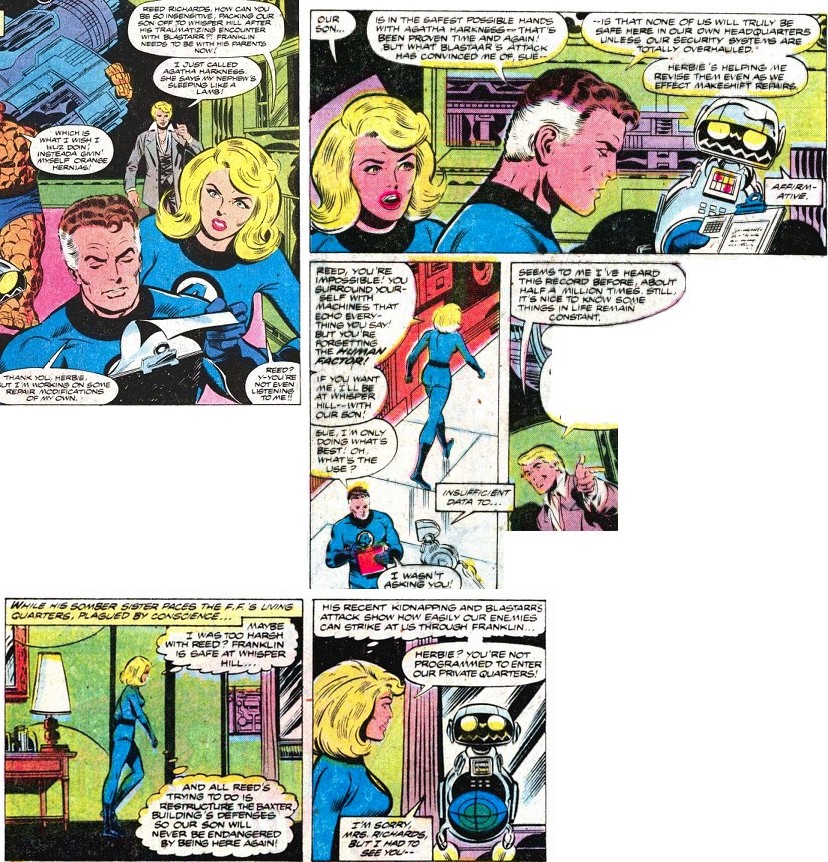
John Byrne's Reed starts here
This issue is a historic milestone: it's where Reed puts up his mental
barriers. Most fans are familiar with John Byrne's Reed Richards: a man
who seldom reacts emotionally. But Byrne's Reed is
different from the action hero Reed
of previous years: the previous Reed was very emotional. So what
happened? If we study Reed's life we can see that series of disasters
caused him to become emotionally withdrawn. The whole of act 4 has been
disaster after disaster, and while the triumph over Doom was a great
success, Reed must by now be getting reports that the Latverian
democracy is not going well. But the greatest humiliation is being
unable to fix the aging ray (see notes to FF210), culminating in almost
causing the end of the world (by having to call on Galactus). Then no
sooner are they back than Reed's negative zone portal fails.
If we plot all of Reed's success and failures on a graph, this period is
the steepest ever decline, and must have felt even worse because it
comes after the triumph when Reed thought he had finally put his
failures behind him.
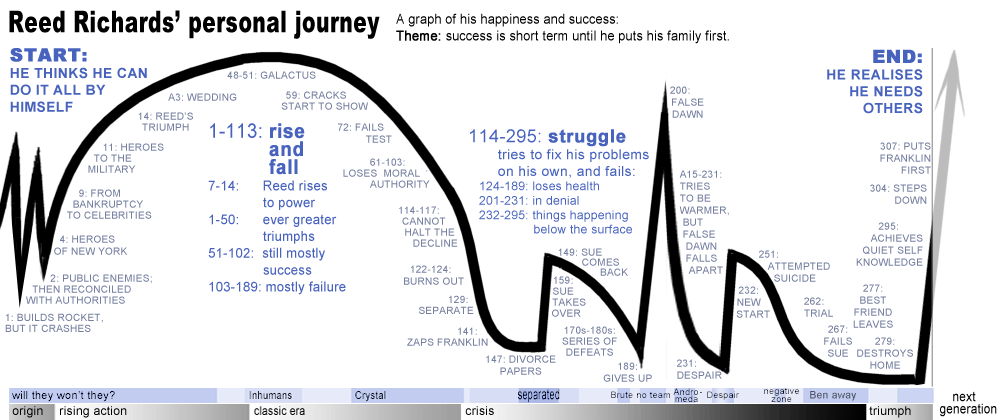
All the
frustration and fears of the 1970s must be returning. But this time
instead of going to pieces, Reed is bottling it up. He is emotionally
unresponsive to Sue. He is shutting himself off from other people.
Symbolism
Reed's barriers are symbolized by the negative zone barrier that is the
focus of this issue. For most of the issue Ben is shown carrying the
timing device that locks the barrier. This is significant, as Ben is the
constant reminder of Reed's failures: Reed caused Ben to become the
Thing, and Reed has been unable to cure him ever since. Johnny's return
to the 1970s (and familiar failure) reflects Reed's return to all his
failures of that era.
Reed then, and Reed now
This issue focuses on four age groups:
- children (Franklin and Herbie, the robot from the children's FF cartoon)
- younger adults (Johnny and the Dazzler)
- the older generation (Sue and Reed)
- and the very old (Dr Sun, who is effectively immortal, and the living computers of Xandar)
This is just one of the pointers that the theme is time. Other pointers are:
- the previous story arc about aging
- the large timing mechanism that Ben carries on the splash page and through most of the story
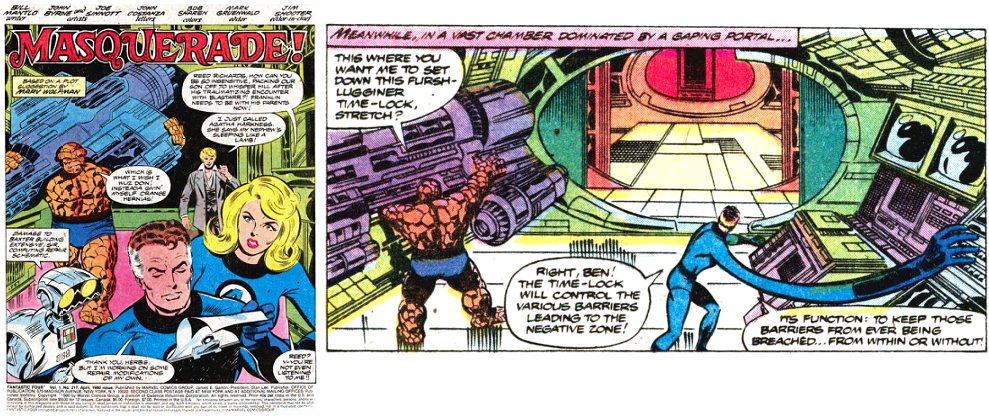
- numerous parallels with 100 issues earlier
The 100 issue cycle
Let us compare 217 and 117:
- The aftermath
Both come after the longest story arc so far: the Overmind saga (4
issues, joint longest with Latveria and Skrull planet stories at that
point), and the Xandar saga (11 issues, the longest ever)
- About the Übermensch
Both sagas were about the desire to be a superior mind: in 117 it is
Reed as the "Übermensch" or Overmind, and here it is the living
computers that are such a magnet for Quasimodo, Dr Sun, the Sphinx, etc.
It raises the question: when some person or entity is more intelligent
than any human, what becomes of the human race? Do they stay as slaves,
or as food, or will they just be wiped out?
- Reed's failure
Both were about Reed trying to too much, and failing disastrously
- Unleashing evil
In Both, Reed almost caused catastrophe by unleashing beings he could not handle (Scratch -see notes to 115- and Galactus)
- Humiliated
In Both, the situation was only saved by appealing to the deadliest enemy (Doom in FF116, Galactus in FF213)
- Whisper Hill
Both feature Whisper Hill (in 117 Reed and Sue are there to mend their
marriage; in 217 Sue is angry at Reed and plans to go there alone)
- Nicholas Scratch
Both (probably) feature another failed parent: Agatha and her son
Nicholas Scratch: for 117 see the notes to the Overmind Saga; for 217
see Reed's ironic reference to Franklin being safe with Agatha: they
were only just kidnapped by Scratch, and soon Franklin will be kidnapped
again, leading Sue and Reed to finally take their son back home.
- Prequel to Franklin
Both are the beginning of a 24 issue build up to Franklin losing
unleashing his power, only to have Reed shut most of his mind down. (in
FF141, and later in FF241 CHECK THIS)
- Prequel to the downward spiral
Both resulted in a rapid downward spiral for Reed (117 led to the near
divorce; for the issues after 2176 see the notes on Moench's run,
219-231)
But the Great American Novel never repeats a story. so let's see the crucial difference:
Reed grows up.
Taking the long view, FF117 eventually leads to a false dawn where Reed
thinks he has finally won (FF200). But this time Reed can have no
illusions. In FF117 Reed was like a young man who thinks he can do
anything. In FF217 Reed is like a middle aged man who can no longer do
as much but refuses to accept it. Eventually, in FF1295, Reed will be
like an old man who finally admits that maybe he was wrong.
This time Sue won't leave
In FF117 Sue and Reed take time away at Whisper Hill to try and mend
their marriage.This did not work, so eventually Sue left to stay with
her friends in the country. But this time Sue has vowed never to leave
(see FF189) and so they stay together and soon take a holiday together
(in FF227).
Franklin
The biggest change now is that (in FF223) they finally realize that
Franklin should with them. This is a step forward. But the final step
will not take place until the next great crisis, at the end of act 4,
when they finally agree that Franklin should not only be with them but
his needs must come first.
The title: "masquerade"
The splash page informs us that this story was suggested by Marv
Wolfman. So we know it's going to be good. The title, "masquerade",
obviously refers on the surface to Dr Sun, masquerading as Herbie. But
it can also refer to Reed pretending to be in control when he is not.

Reed is clearly in denial. he says that Franklin "is in the safest
possible hands with Agatha Harkness that has been proven time and
again" Really?? Annual 14 was just before the previous issue (which
continues seamlessly into this one), when Agatha invited them all to
Salem, where Franklin was traumatized! (The cover to the annual showed
Franklin, alone, with the line "he's been a child, until now".) In that
annual they recalled the last visit to Salem, in FF 184-186, where
Agatha and Franklin were kidnapped! And before that? Agatha brought
Franklin to Annihilus for FF141. If Reed thinks Franklin is safe with
Agatha he is losing touch with reality - or more likely, refuses to
admit his mistake, as Agatha was Reed's idea in the first place (FF94).
Sue's response: "you surround yourself with machines that echo
everything you say, but you're forgetting the human factor" reminds us
that when Reed makes mistakes he is disturbingly similar to the Mad
Thinker.
The Internet
This
story foreshadows the real world in the 2000s. At first Reed thought
that access to the Internet (a direct link to the Xandarian computers)
had no down side. But Dr Sun was able to use it against him. This is
like the public view of the Internet: in the 1990s it was common to hear
how it would lead to freedom and a new kind of politics, and
governments could do nothing about it. But eventually existing
Governments learned to use the Internet as well. The most noted success
is the "great firewall of China" where China controls what its Internet
can say. Note that Dr Sun is Chinese.
The zeitgeist
To draw a
contrast with Reed's emotional coldness, Johnny is shown having a wild
time at the disco. In this issue the 1970s disco craze finally comes to
the Fantastic Four! Just in time to go out of fashion, reminding us
that Johnny never had the wild life he wanted, because his family and
duty always came first.as Disco was never
high on the radar for comic creators (too old) or comic readers (too
bookish). Disco's appearance in mainstream comics signaled it had
finally reached every corner of the nation, and was thus at the end
of its fashion. Dazzler was planned in 1979, the year of the
anti-disco "Disco Demolition" in Chicago. This issue was on sale in
January 1980, just before the release of "I Will Survive," the last
great disco classic. After that, Disco was soon replaced by punk and
the "Flash Dance" style seen in John Byrne's run.
"Studio infinity"
Johnny visits Studio infinity...
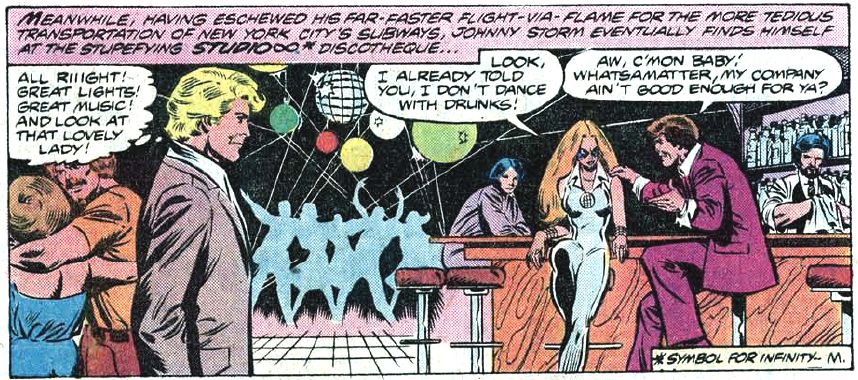
A reference to the famous Studio 54
(this image is from its second opening, 1997-2012. The 1970s photos are
usually black and white, heavily copyrighted, and don't show much
beyond crowds)

"In terms of the evolution of disco
then 1974 is regarded as the seminal year, and 1977 its peak. By 1979
the backlash had already begun (including the infamous “Disco Sucks"
protests and the Chicago Cubs smashing of records) and a new wave about
to be phased in. It traditionally tapped into the gay scene, which makes
it doubly amusing that the can-never-settle-down flash Johnny tries it
out." - 'Richard'
Deep philosophy and ethics
The Great American Novel deals with deep topics. Reed argues that
Herbie was never alive, so his death does not matter. Reed cannot
connect to Herbie on an emotional level, just as he cannot connect
to Franklin or anybody else without great effort. Ben makes the
philosophical behaviorist argument that Herbie acted alive, and
therefore he was. ironically this is the more objective, clinical
approach: there is no fundamental difference between life and a
complex machine. But Reed never thinks of big abstractions like
that.
A lot of readers disliked Herbie, but many of them felt
genuinely sad when he died. It forces us to examine how we think
about the annoying and unpopular kids who seem less important than
other people. Deep stuff.
Other points to note
- We continue to see Johnny's insecurity around women. This will
be his last weakness to fall, in act 5.
- For more about Herbie's life and death, see notes to FF209.
218
Issue 218, the Spider-Man issue: how well can we hide our identity?

This is about Spider-Man, not the FF
Continuing the theme of masquerade from the previous issue, this issue
is about disguises. Specifically, Paste Pot Pete and Spider-Man.
Why focus on Spider-Man and not the FF? Because the writer of this issue
was a Spider-Man expert who wrote the issue at short notice, filling
a gap before Doug Moench took over.
"Archie Goodwin was originally announced as new FF
writer beginning with this issue, but the firing of Rick
Marschall by Jim Shooter caused Archie to grab the editor spot
of Epic magazine instead." (source)
"Since Bill Mantlo is filling in
on writing chores after Wolfman’s abrupt departure as both
writer and editor, it makes sense that there’s a Spidey
crossover. This issue finished a story that started in
Peter Parker the Spectacular Spider-Man #42, a series on which
Mantlo was a regular writer." (source)
Once again I have to stress what I always say: none of this was
intentional. But the stories are bigger than the writers and I am just
trying to make sense of what finally appeared on the page.
This issue is a big deal
This is the final "Frightful Four" story, insofar as that title
meant anything. The original Frightful Four was supposed to be a team
of equals: Peter Petruski began it by rescuing the Wizard. Although the
Wizard treats others as worthless, as long as Peter was there the team
was in theory kind of equal. But being with the Wizard so long destroyed
any possibility of a team. This is Petruski's final team issue. After
this the Wizard will come back, with the Sandman (because he has his own
reasons), but it's basically just the Wizard and whoever he can hire at
the time. The Wizard is Reed's arrogance magnified until it makes a
team impossible.
This issue had a big build up in the "Spectacular Spider-Man" comic.
For several issues (39-42) the Wizard and Pete planned their final
revenge on both Spidey and the FF. And this issue, FF 218, is where it
happens: and it's a fiasco. This is where the Frightful; Four lose
whatever credibility it may have had. From here it's all over. After
this the Wizard returns one more time, for the final showdown in act 5,
but it's all pathetic really, and it's really Aron the rogue Watcher who
calls the shots.
This is Peter's big test
The rest of the Frightful Four watch the Trapster: this seems to be his
big test. He has to enter the building, defeat the Torch and the Thing,
and disable the alarms, on his own. We can infer that they had a lot of
arguing behind the scenes (they argue plenty when we see them so this is
not a big stretch). You can imagine great shouting matches where the
Wizard says Pete is useless and Pete says he will prove himself once and
for all. And he fails. Even his paste fails: both Spidey and Reed are
able to break it. It's all over for Pete. He will make one last attempt
(FF 265) but the result is predictable. Peter Petruski is not the man he thinks he is.
Why Peter Petruski is like Peter Parker
Spider-Man and Paste Pot Pete both appeared with a very similar
material in 1963: a super-adhesive that expands forcefully on contact
with air, can be formed into long strings or ropes, and dissolves after
an hour. They both claimed to invent
it, but neither seemed interested in selling it (see below), and in
Spider-Man's
case the first version was much better than later versions. This all
suggests that they both discovered the same material. Peter Parker
refined his into a very thin strand (though he sometimes used it just
as glue), and Peter Peter preferred to use his as thick ropes. But both
use them for the same general purposes: for ropes, for sticking to
things, for tying things up, etc,
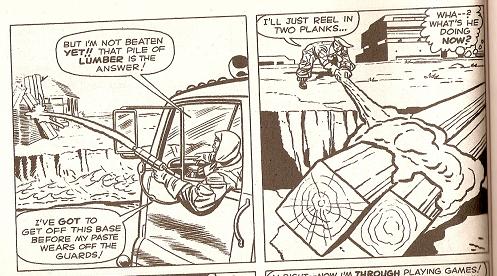
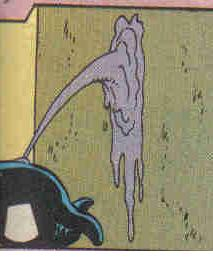
When we follow Peter Peter's career we see that he and Peter Parker
are almost exactly the same. Except that when Parker's Uncle Ben died it
made him less greedy: it made him think of others.
But neither of the Peters has much success. A third parallel of course
is Reed Richards: Reed also discovered alien technology, but he never
tried a secret identity. He very publicly devoted himself to studying
what he found. Being public is just a much more sensible option. We
should not hide our true selves.Reed is more secure in his identity and
so he wins. It's all very Shakespearean.
Shakespeare and The Great American Novel
This issue is about true identities. This is a common theme in
Shakespeare: people disguise themselves, and being their true self is
often the core of the plot. This story is about Peter Parker and Peter
Peter, two parallel lives. It is about identity. Throughout the story,
everyone takes on false identities:
- Spider-man always hides his identity.
- The Trapster pretends to be Spider-Man.
- The Invisible Girl hides, but cannot hide her ordinary clothing (symbolizing how hiding cannot always work in the real world)
- The Trapster pretends to be brave when he is not.
- At the end the FF pretend to be cruel when they are not.
- Etc.
The Fantastic Four is about realism. When people have more power than others, how do they behave?
- Sometimes, like Reed, they become self important, arrogant, without meaning to.
- Other times, as with Ben, they can't handle it.
- Sometimes, as with Sue, they don't want it.
- And other times, as with Johnny, they embrace it but it never
works out as they want (e.g. he has no power over his life and can't get
a girlfriend who will stay).
People with wealth and power often pretend it will not change them.
But it has to: it cannot help but change them This is symbolized by the
question of secret identities. A super powered secret identity can never
fully work in the real world, because:
- The media would follow you.
- Enemies would follow you.
- The government would follow you.
- It's immoral. If you worked full time as a hero you could save more lives. People are dying because you want a secret identity.
- it causes you endless problems: how do you explain your sudden disappearances to your employer or boyfriend?
- Fighting crime (or whatever) is expensive: unless your parents are billionaires you can't do this part time.
Realistically, there are only two reasons for a secret identity:
- Illegality: You want to commit crime
- Inexperience: You are very new to the superhero game and haven't
got it worked out yet. Steve Ditko got it right. Early Spider-Man
stories are realistic, because he was just a kid, and hadn't got it all
worked out. But when he became a man he would stop behaving like a kid
and move on.
About Spider-Man
The original Steve Ditko Spider-Man was realistic: that is just how a
kid would behave when coming to terms with great power.
Ditko argued that a hero would then grow up (and in Ditko's opinion
become like "The Question" or "Mr A"). In this web site I argue that
Peter Parker remained as the mixed up kid, but we also see his other
possible career path, as criminal.
The names "Peter Parker" and "Peter Peter"
In the FF comic, Peter Petruski (Paste Pot Pete, or the Trapster) is
what could have happened to Spider-Man, had he followed the criminal
route. Petruski is a variant form of the Polish name Petrowski, and
means "from Peter". The Trapster is "the Peter from Peter". Meanwhile
"Parker" means the person who looks after the park: Peter Parker cares
for those around him, whereas Peter Peter only cares for Peter.
Both Peters began in 1963. Here I will argue that they are
essentially the same character, but their paths diverged when Parker's
uncle died. At first neither cared about crime (Peter let a criminal
escape) and this led to the death of Ben Parker ("Ben" means "son of",
so Bens tend to be "everyman" characters). This changed Peter
Parker's outlook. But Peter Petruski had the opposite experience: he
found that the more he ignored morality, the more money he made, so he
chose that route.
Why didn't he sell the web formula?
Both Peters wanted money. Super adhesive or webbing are such useful inventions that they could
become billionaires just by selling it. So why don't they? The clue is
that Peter's early webbing could do far more than the later stuff (see
the first time Peter met the FF for example). Obviously he would
experiment with it, but it does seem that he could not duplicate its
best properties. And note that vast quantities come from tiny web
shooters: to some extent the material seems to expand to replenish
itself, just like the unstable molecule Skrull milk and Skrull spray in
FF annual 16. (According to Spidey's own book he does run out of webbing
sometimes, but there could be other reasons for this, related to how he
experiments with the material, plus Spidey's own book may not be
reliable: see below). If both Peters want money yet do not sell
their billion dollar "invention" it seems likely that they only have one
source that replenishes itself, and they experiment with it but only have a vague idea of how it works.
The real Peter Parker
In his own comic, Peter Parker is shown as being super strong, having an
amazing spider-sense, being super smart, and having invented amazing
webbing. But the more realistic Fantastic Four shows the real story:
Spider-man is a guy who discovered an alien substance he used as
webbing, and that may be his only power. In the FF we really don't know
much about Parker's private life, or even if that is his real name: if
he has a secret identity then obviously it would not be published in a
comic! Let's look at what we know about Spider-Man from his appearances
in the FF. Remember that only the FF report directly to Marvel, so these
are the reliable stories.
Spider-Man in his own comic
In his own comics Spider-Man is a mostly successful crime fighter. But
this requires him to never learn from his mistakes (why does he have the
same problems a teenager would have?), and he uses web shooters that
are far in advance of anything human scientists could invent. This and
other features make him unrealistic. Yet it could still be an example of
"magical realism": where something impossible is used in a story, as a
quick way to see how a person reacts. So the modern Spider-man can still
be realistic in a way. I would love to se a web site that explores that
realism.
Until a serious realism-based Spider-Man web site is made then we
have to work with what we have. This web site will apply Occam's razor
and just say "Spider-Man is unrealistic. We can enjoy his stories as
fables, but not realistically." So what are we to do with the references
to Spider-Man in the FF comic? If we examine those references
realistically, a very different kind of Spider-Man emerges.
Spider-Man in the early Fantastic Four
- FF annual 1, story 2: we see that his webbing can do amazing
things at first: far more amazing than anything that comes later. Also,
unfeasibly large amounts of web fluid fit into tiny web cartridges. This and other evidence suggests that he did not invent it,
but discovered an alien substance, and there were limited quantities.
Its ability to last a long time reminds me of the Skrull milk in FF
annual 16. And the black costume that finally took on a life of its own.
At the end of this story Spidey leaves because he doesn't think he can make money from being in the Fantastic Four.
- FF35: we see Peter Parker at school, and his cockiness: he's not impressed by Johnny.
- FF36: Peter Parker steps aside so Peter Peter can appear for the first time (see below)
- Annual 3 - another appearance in the same comic as Peter Peter.
Here Spider-Man's webbing supports a heavy object (a safe), but we don't
see what is anchoring it at the top: so we cannot see this as evidence
that Spider-Man has super-strength.
- FF61: Peter Parker is in a crowd with a camera.
- FF73: in one frame he appears to stick to a wall, otherwise Peter Parker's only obvious power is his webbing.
- FF111: Parker tries to sell photos to Jameson, but is ignored
- FF133: in the same story as Peter Peter again. He uses his web.
- FF204: Peter is fighting "Manwolf" and apparently losing,
- FF207: Peter sticks to a stone wall, but Johnny is asleep, so
cannot have reported this incident to Marvel. We only have Peter's
description, if any. He smashes open an ordinary door, but again there
are no witnesses, and we don't know how strong the door is. He is seen
lifting two men, which indicates he is at peak physical fitness.
- FF annual 14: he appears to use a "spider sense", but the rushing
terrified crowds men he didn't need any special skills to notice there
was danger nearby!
- This issue: we once see Peter apparently hold onto a wall with his
hands, but the wall is covered with machinery so there is plenty to
hold onto if needed.
- FF242: he uses his webbing again. Once again he appears to use a
spider-sense, but the danger was obvious to anyone who glanced out of
the nearby window, so there is no need for any special power.
- FF243: he is briefly seen on a wall, but not climbing, just sticking.
- FF250: he just swings and talks.
- FF299: he just swings then talks, and shows he knows more about relationships than Johnny does.
So applying Occam's razor (hat is, always taking the simplest
possible explanation), this is what we know for sure about Spider-Man:
- He discovered some kind of alien glue that could be used for shooting sticky ropes.
- He might also use it for sticking to walls (presumably
reformulated, so he only sticks as much as he needs to and it dissolves
more quickly)
- He trained himself to the peak of physical fitness
- He is confident and wisecracking
- He has bad luck.
Summary of similarities
We first meet Peter Peter in FF36, where we are reminded of his Strange Tales appearance, and his similarities with Spider-Man:
- He uses his glue as webbing, to swing through the sky
- His initial goal was to make money (see Peter's wrestling career and his reason for trying to join the FF)
- He sometimes uses it to climb walls. (The suction cups in FF208
needed help: they won't work on wet concrete. Peter is an expert on
adhesives, so they almost certainly had some kind of quick dissolving
glue assistance)
- It dissolves after an hour (as we saw in Strange Tales)
- He stashes his clothes away when in costume
- He's an inventor and smart guy, brimming with confidence
- He is a natural loner: becoming part of a team dos not work for him (the Wizard's team destroyed his confidence).
- His bad luck means he never gets what he wants.
- But his confidence will be knocked by his bad luck. inability to
make things happen: nothing ever works out how he wanted (in this case,
meeting the Wizard spelled the end of his confidence)
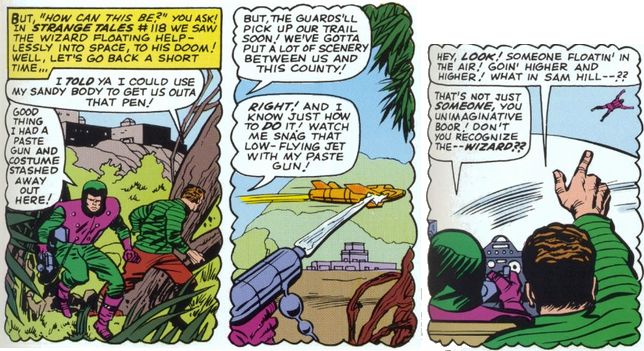
Later we see Peter Parker leave the Baxter Building window just as
Peter Peter approaches it for the first time. Note the symbolism: this
is a window on two very private Peters: one leaves so the other can enter
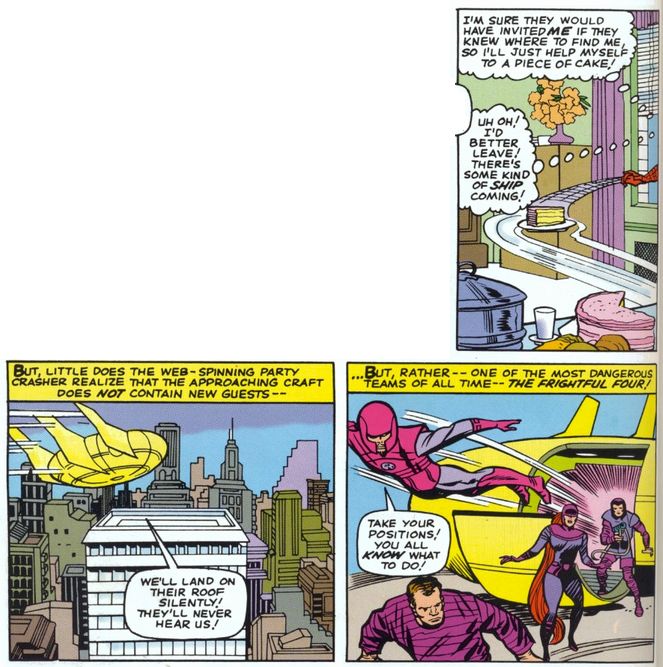
Goodbye Paste Pot Pete
This issue is the end of
Peter's career with the Frightful Four. At the end he just goes to
pieces. He will make one final attempt to function - his next appearance
will be on his own - and that will end with his utter humiliation and
fade into blackness. After that he will never to be seen again (in the
28 year story). Both this and his final story take place at night,
reflecting the darkness of this final act in Peter's career. For more about Peter as a person,
click here.

Other points to note
Younger readers may think that "husbandly duties" refers to sex.
But Sue's concern at this point is that Reed spends time with her.
The last thing she wants is to be treated like one of Reed's
machines, just a simple physical function to be discharged.
Maybe she wants his body, but far more than that she she wants his
attention.



















 FF201
202
203
annual 12
204
205
206
207
208
209
210
211
212
213
214
215
annual 14
216
217
218
FF201
202
203
annual 12
204
205
206
207
208
209
210
211
212
213
214
215
annual 14
216
217
218






























































